Attached files
| file | filename |
|---|---|
| 8-K - 8-K - Cardiff Oncology, Inc. | crdf8-k060121.htm |

Turning the Tide on Cancer June 2021
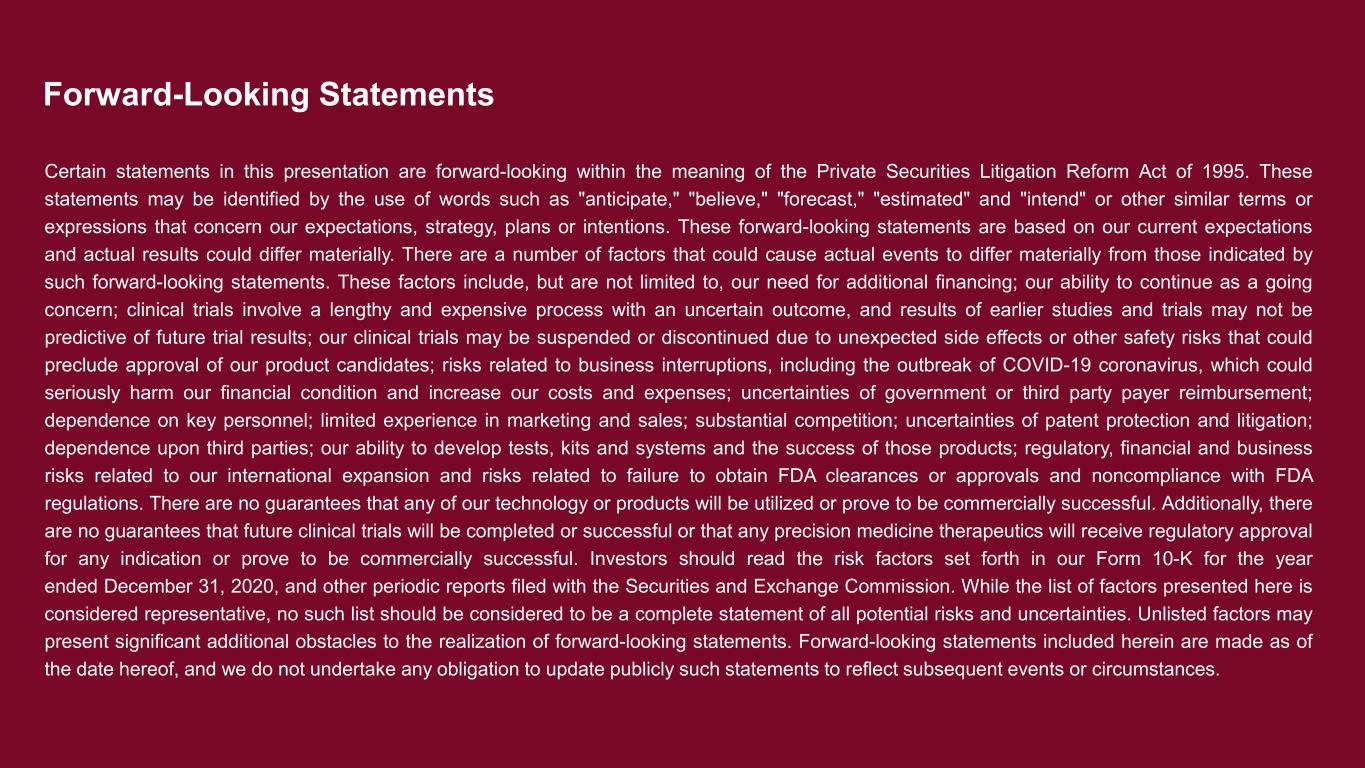
2021 Corporation Presentation I 2 Certain statements in this presentation are forward-looking within the meaning of the Private Securities Litigation Reform Act of 1995. These statements may be identified by the use of words such as "anticipate," "believe," "forecast," "estimated" and "intend" or other similar terms or expressions that concern our expectations, strategy, plans or intentions. These forward-looking statements are based on our current expectations and actual results could differ materially. There are a number of factors that could cause actual events to differ materially from those indicated by such forward-looking statements. These factors include, but are not limited to, our need for additional financing; our ability to continue as a going concern; clinical trials involve a lengthy and expensive process with an uncertain outcome, and results of earlier studies and trials may not be predictive of future trial results; our clinical trials may be suspended or discontinued due to unexpected side effects or other safety risks that could preclude approval of our product candidates; risks related to business interruptions, including the outbreak of COVID-19 coronavirus, which could seriously harm our financial condition and increase our costs and expenses; uncertainties of government or third party payer reimbursement; dependence on key personnel; limited experience in marketing and sales; substantial competition; uncertainties of patent protection and litigation; dependence upon third parties; our ability to develop tests, kits and systems and the success of those products; regulatory, financial and business risks related to our international expansion and risks related to failure to obtain FDA clearances or approvals and noncompliance with FDA regulations. There are no guarantees that any of our technology or products will be utilized or prove to be commercially successful. Additionally, there are no guarantees that future clinical trials will be completed or successful or that any precision medicine therapeutics will receive regulatory approval for any indication or prove to be commercially successful. Investors should read the risk factors set forth in our Form 10-K for the year ended December 31, 2020, and other periodic reports filed with the Securities and Exchange Commission. While the list of factors presented here is considered representative, no such list should be considered to be a complete statement of all potential risks and uncertainties. Unlisted factors may present significant additional obstacles to the realization of forward-looking statements. Forward-looking statements included herein are made as of the date hereof, and we do not undertake any obligation to update publicly such statements to reflect subsequent events or circumstances. Forward-Looking Statements
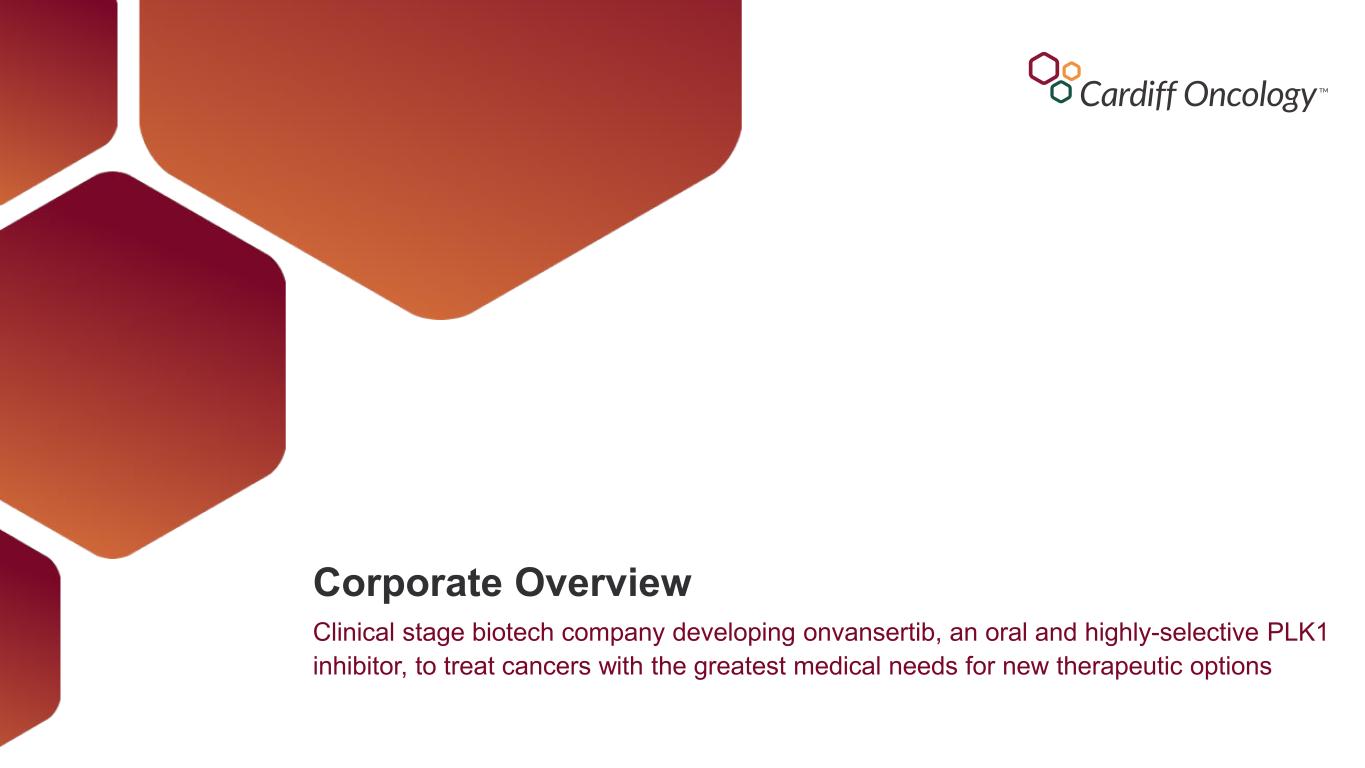
Corporate Overview Clinical stage biotech company developing onvansertib, an oral and highly-selective PLK1 inhibitor, to treat cancers with the greatest medical needs for new therapeutic options
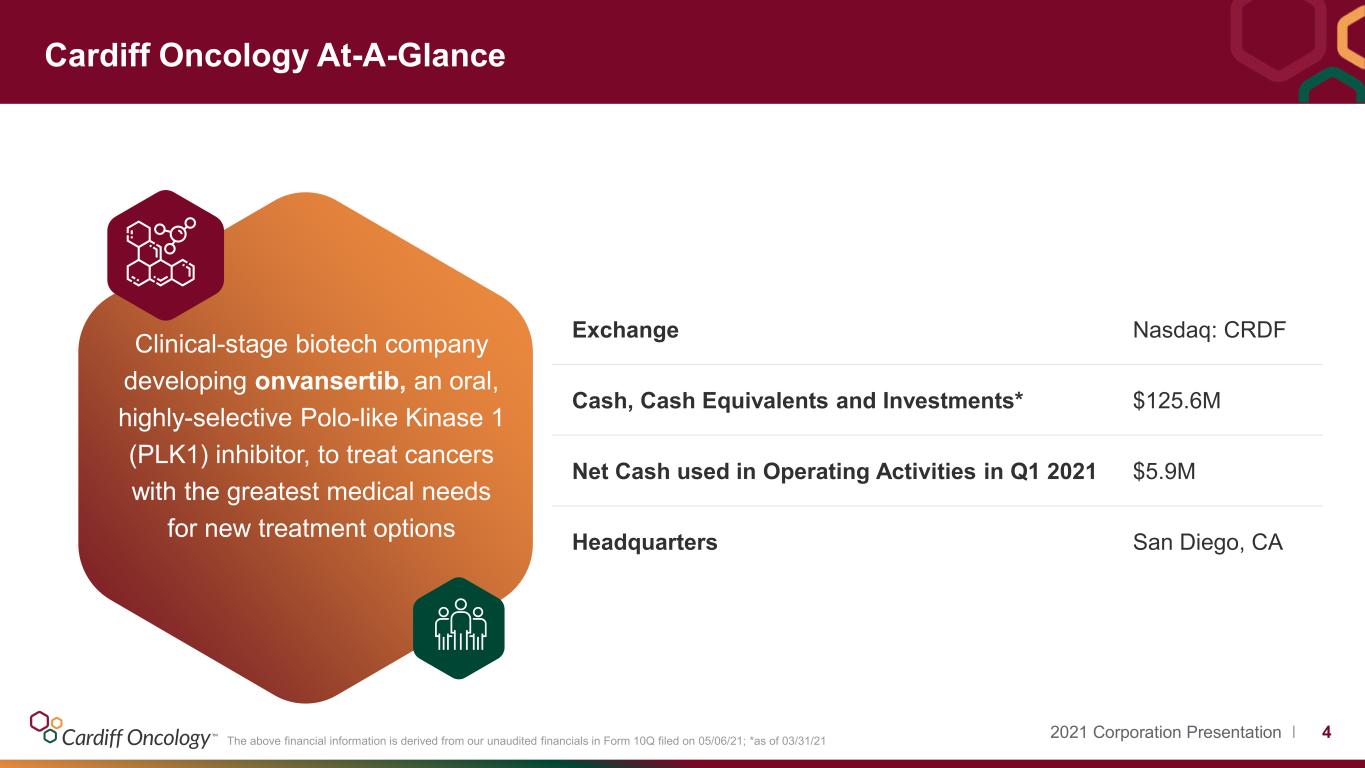
2021 Corporation Presentation I 4 Clinical-stage biotech company developing onvansertib, an oral, highly-selective Polo-like Kinase 1 (PLK1) inhibitor, to treat cancers with the greatest medical needs for new treatment options Cardiff Oncology At-A-Glance Exchange Nasdaq: CRDF Cash, Cash Equivalents and Investments* $125.6M Net Cash used in Operating Activities in Q1 2021 $5.9M Headquarters San Diego, CA The above financial information is derived from our unaudited financials in Form 10Q filed on 05/06/21; *as of 03/31/21
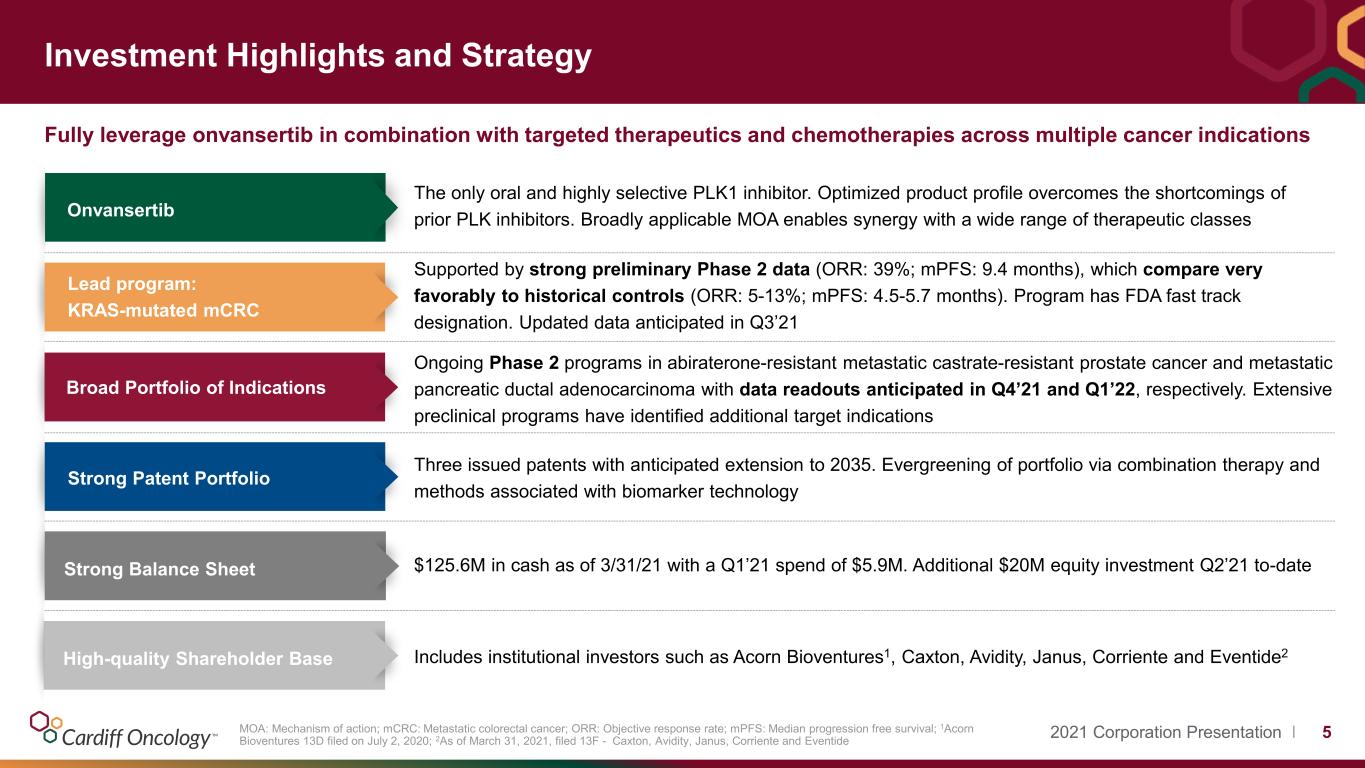
2021 Corporation Presentation I 5 Investment Highlights and Strategy Fully leverage onvansertib in combination with targeted therapeutics and chemotherapies across multiple cancer indications MOA: Mechanism of action; mCRC: Metastatic colorectal cancer; ORR: Objective response rate; mPFS: Median progression free survival; 1Acorn Bioventures 13D filed on July 2, 2020; 2As of March 31, 2021, filed 13F - Caxton, Avidity, Janus, Corriente and Eventide The only oral and highly selective PLK1 inhibitor. Optimized product profile overcomes the shortcomings of prior PLK inhibitors. Broadly applicable MOA enables synergy with a wide range of therapeutic classesOnvansertib Supported by strong preliminary Phase 2 data (ORR: 39%; mPFS: 9.4 months), which compare very favorably to historical controls (ORR: 5-13%; mPFS: 4.5-5.7 months). Program has FDA fast track designation. Updated data anticipated in Q3’21 Lead program: KRAS-mutated mCRC Ongoing Phase 2 programs in abiraterone-resistant metastatic castrate-resistant prostate cancer and metastatic pancreatic ductal adenocarcinoma with data readouts anticipated in Q4’21 and Q1’22, respectively. Extensive preclinical programs have identified additional target indications Broad Portfolio of Indications Three issued patents with anticipated extension to 2035. Evergreening of portfolio via combination therapy and methods associated with biomarker technology Strong Patent Portfolio Includes institutional investors such as Acorn Bioventures1, Caxton, Avidity, Janus, Corriente and Eventide2High-quality Shareholder Base Strong Balance Sheet $125.6M in cash as of 3/31/21 with a Q1’21 spend of $5.9M. Additional $20M equity investment Q2’21 to-date
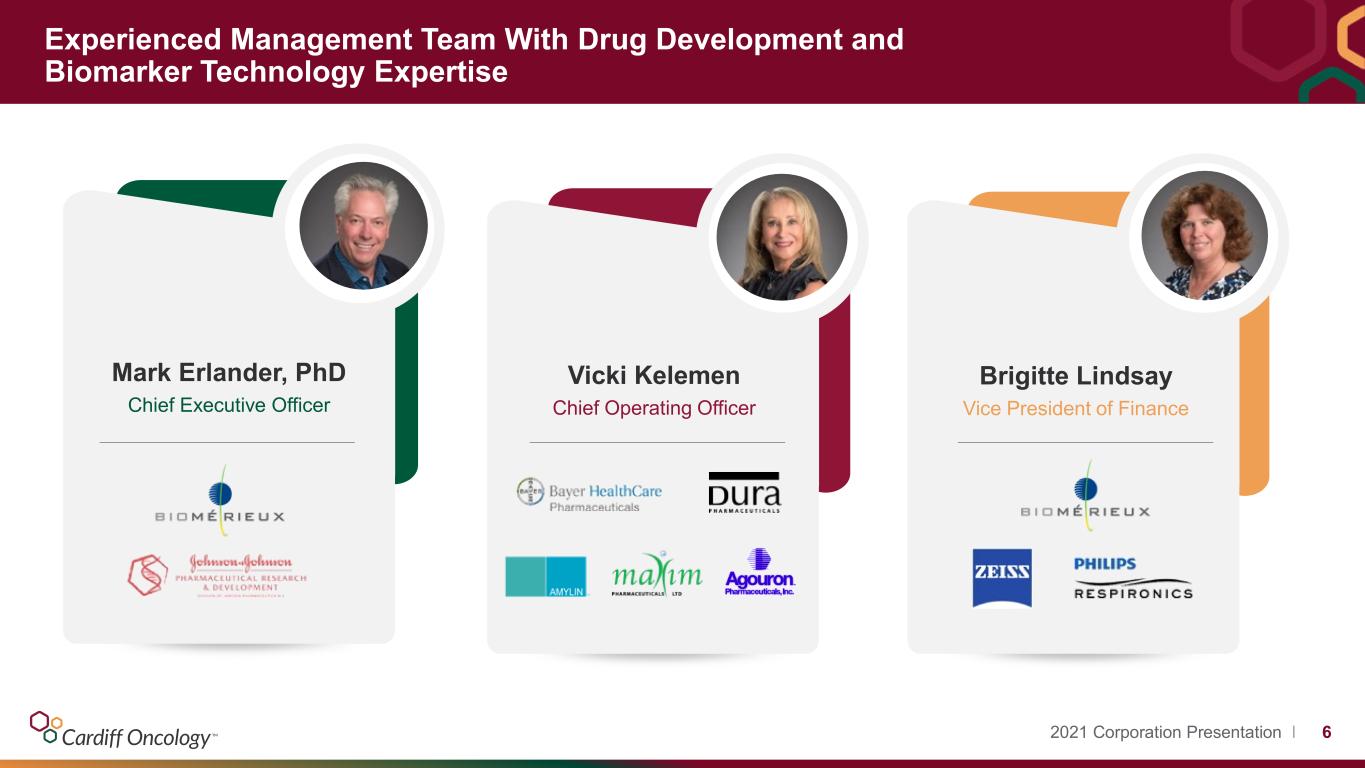
2021 Corporation Presentation I 6 Mark Erlander, PhD Chief Executive Officer Vicki Kelemen Chief Operating Officer Experienced Management Team With Drug Development and Biomarker Technology Expertise Brigitte Lindsay Vice President of Finance
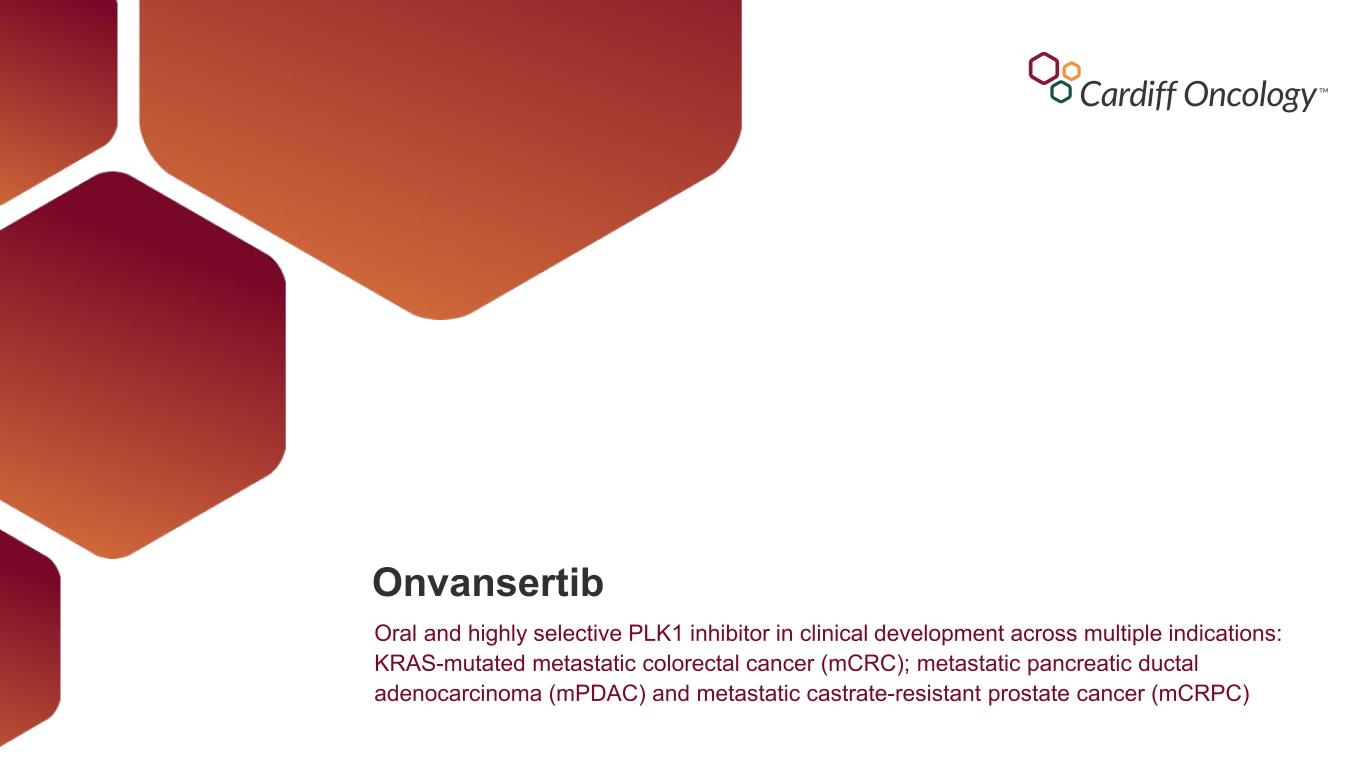
Onvansertib Oral and highly selective PLK1 inhibitor in clinical development across multiple indications: KRAS-mutated metastatic colorectal cancer (mCRC); metastatic pancreatic ductal adenocarcinoma (mPDAC) and metastatic castrate-resistant prostate cancer (mCRPC)
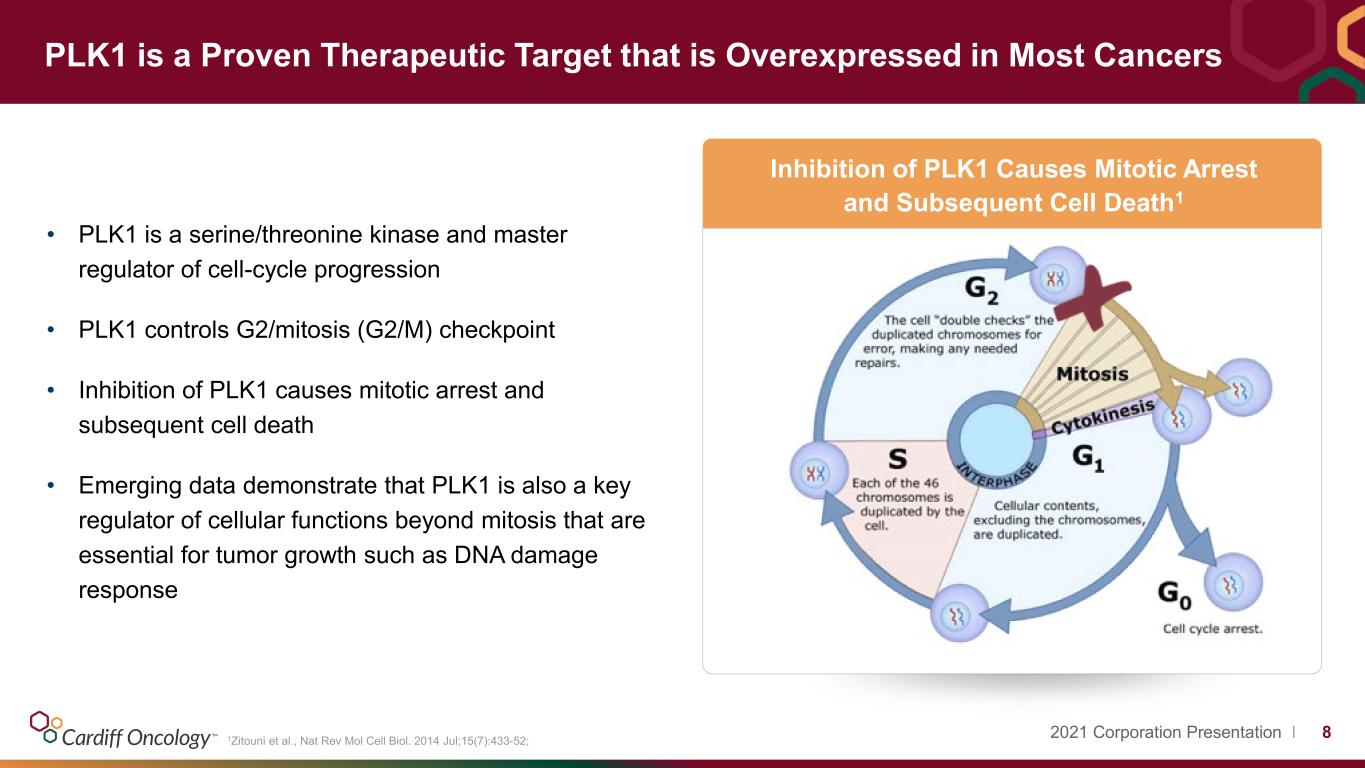
2021 Corporation Presentation I 81Zitouni et al., Nat Rev Mol Cell Biol. 2014 Jul;15(7):433-52; PLK1 is a Proven Therapeutic Target that is Overexpressed in Most Cancers Inhibition of PLK1 Causes Mitotic Arrest and Subsequent Cell Death1 • PLK1 is a serine/threonine kinase and master regulator of cell-cycle progression • PLK1 controls G2/mitosis (G2/M) checkpoint • Inhibition of PLK1 causes mitotic arrest and subsequent cell death • Emerging data demonstrate that PLK1 is also a key regulator of cellular functions beyond mitosis that are essential for tumor growth such as DNA damage response
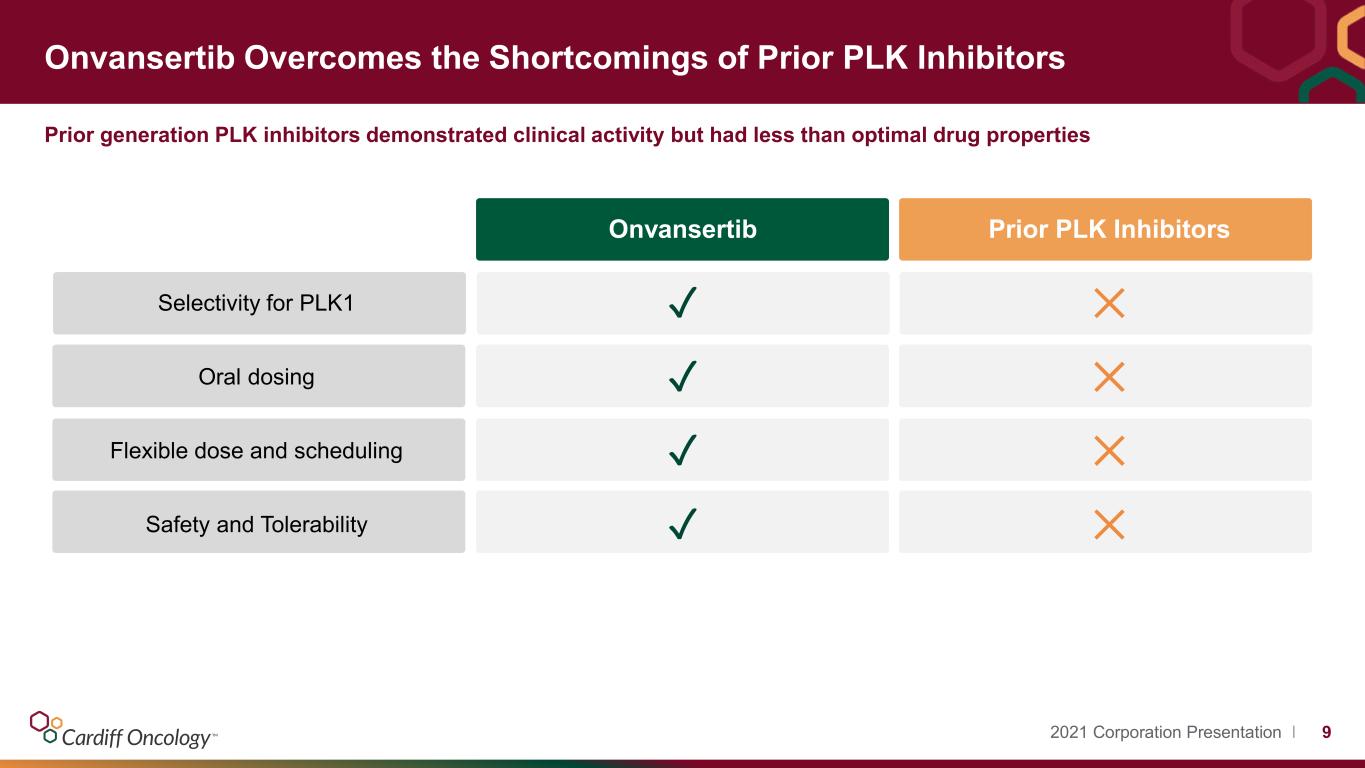
2021 Corporation Presentation I 9 Prior generation PLK inhibitors demonstrated clinical activity but had less than optimal drug properties Onvansertib Overcomes the Shortcomings of Prior PLK Inhibitors Onvansertib Prior PLK Inhibitors Selectivity for PLK1 ✓ ✕ Oral dosing ✓ ✕ Flexible dose and scheduling ✓ ✕ Safety and Tolerability ✓ ✕
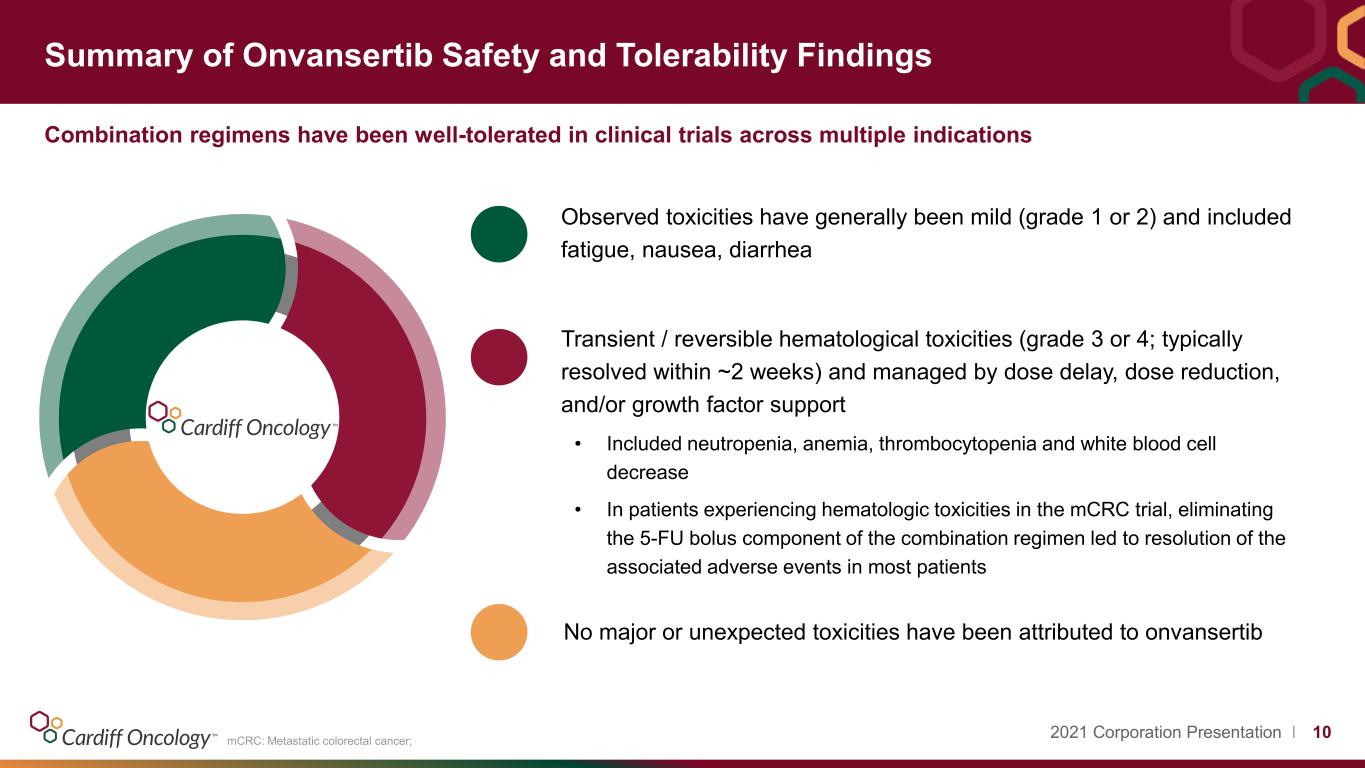
2021 Corporation Presentation I 10 Summary of Onvansertib Safety and Tolerability Findings Combination regimens have been well-tolerated in clinical trials across multiple indications mCRC: Metastatic colorectal cancer; Transient / reversible hematological toxicities (grade 3 or 4; typically resolved within ~2 weeks) and managed by dose delay, dose reduction, and/or growth factor support • Included neutropenia, anemia, thrombocytopenia and white blood cell decrease • In patients experiencing hematologic toxicities in the mCRC trial, eliminating the 5-FU bolus component of the combination regimen led to resolution of the associated adverse events in most patients Observed toxicities have generally been mild (grade 1 or 2) and included fatigue, nausea, diarrhea No major or unexpected toxicities have been attributed to onvansertib
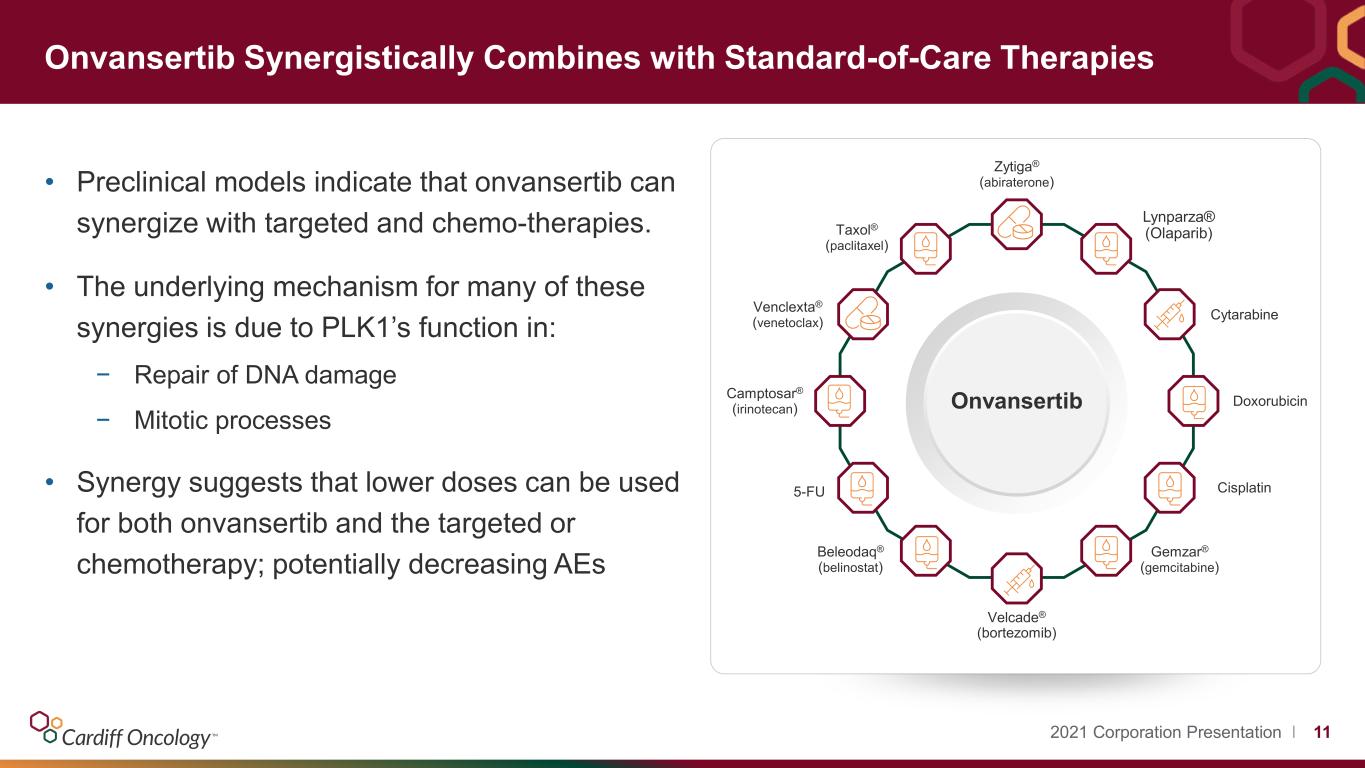
2021 Corporation Presentation I 11 Onvansertib Synergistically Combines with Standard-of-Care Therapies Zytiga® (abiraterone) Lynparza® (Olaparib)Taxol® (paclitaxel) Venclexta® (venetoclax) Cytarabine DoxorubicinCamptosar ® (irinotecan) Beleodaq® (belinostat) Cisplatin Gemzar® (gemcitabine) 5-FU Velcade® (bortezomib) Onvansertib • Preclinical models indicate that onvansertib can synergize with targeted and chemo-therapies. • The underlying mechanism for many of these synergies is due to PLK1’s function in: − Repair of DNA damage − Mitotic processes • Synergy suggests that lower doses can be used for both onvansertib and the targeted or chemotherapy; potentially decreasing AEs
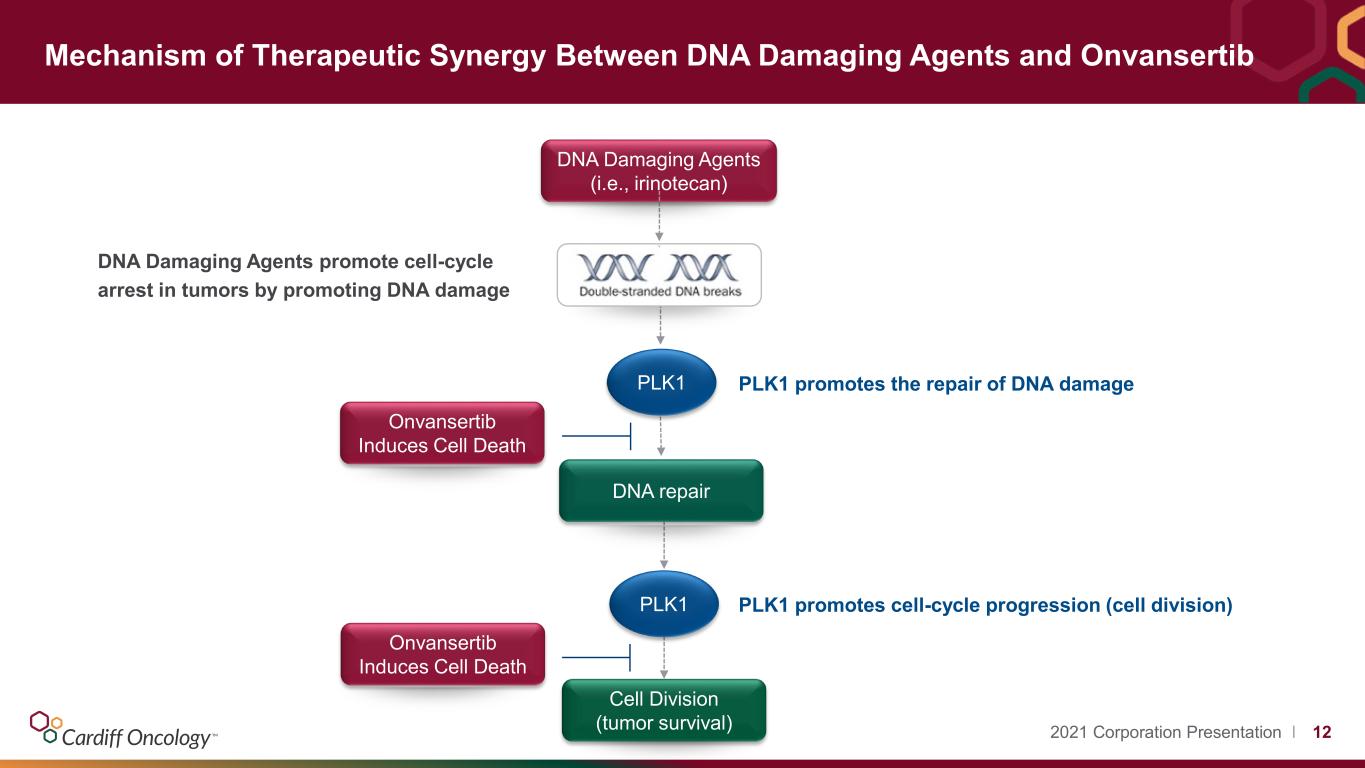
2021 Corporation Presentation I 12 Mechanism of Therapeutic Synergy Between DNA Damaging Agents and Onvansertib DNA Damaging Agents promote cell-cycle arrest in tumors by promoting DNA damage PLK1 promotes the repair of DNA damage DNA Damaging Agents (i.e., irinotecan) Onvansertib Induces Cell Death Cell Division (tumor survival) PLK1 DNA repair PLK1 Onvansertib Induces Cell Death PLK1 promotes cell-cycle progression (cell division)
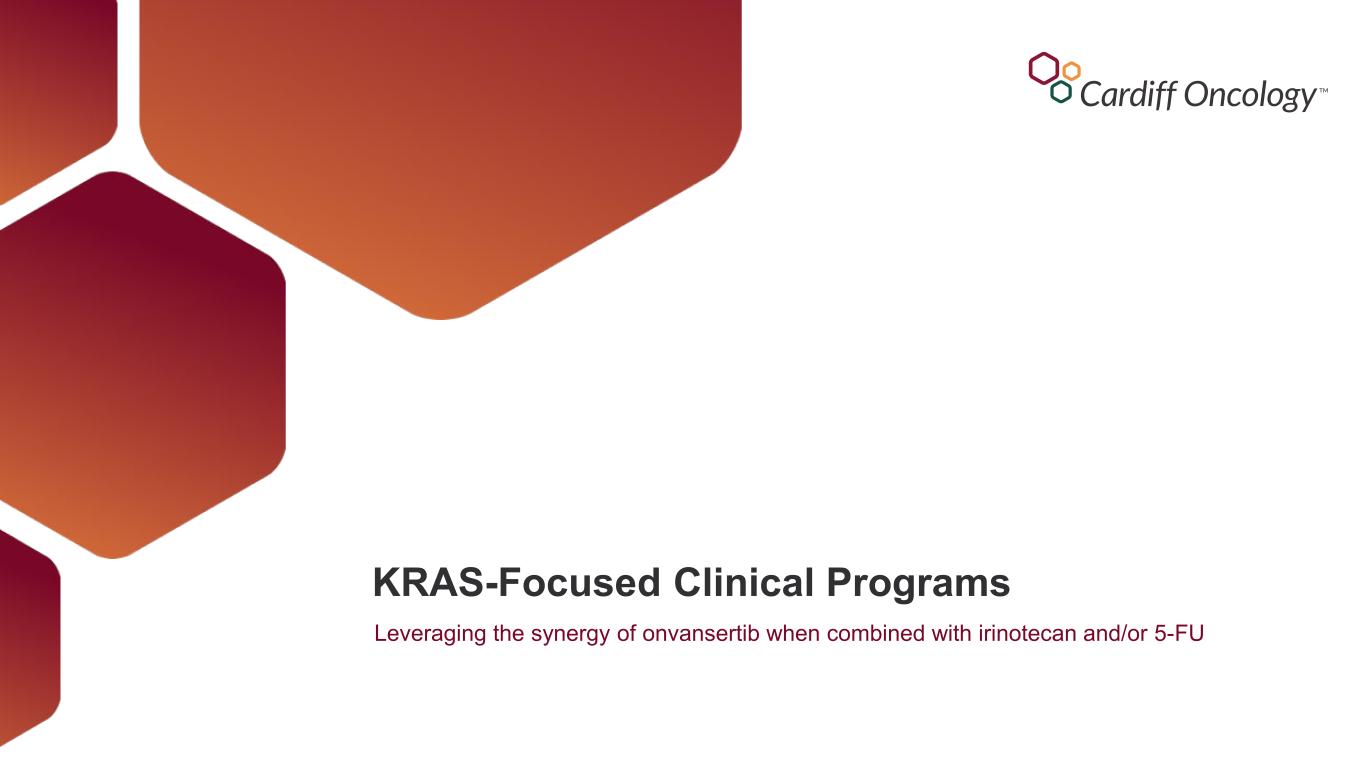
KRAS-Focused Clinical Programs Leveraging the synergy of onvansertib when combined with irinotecan and/or 5-FU
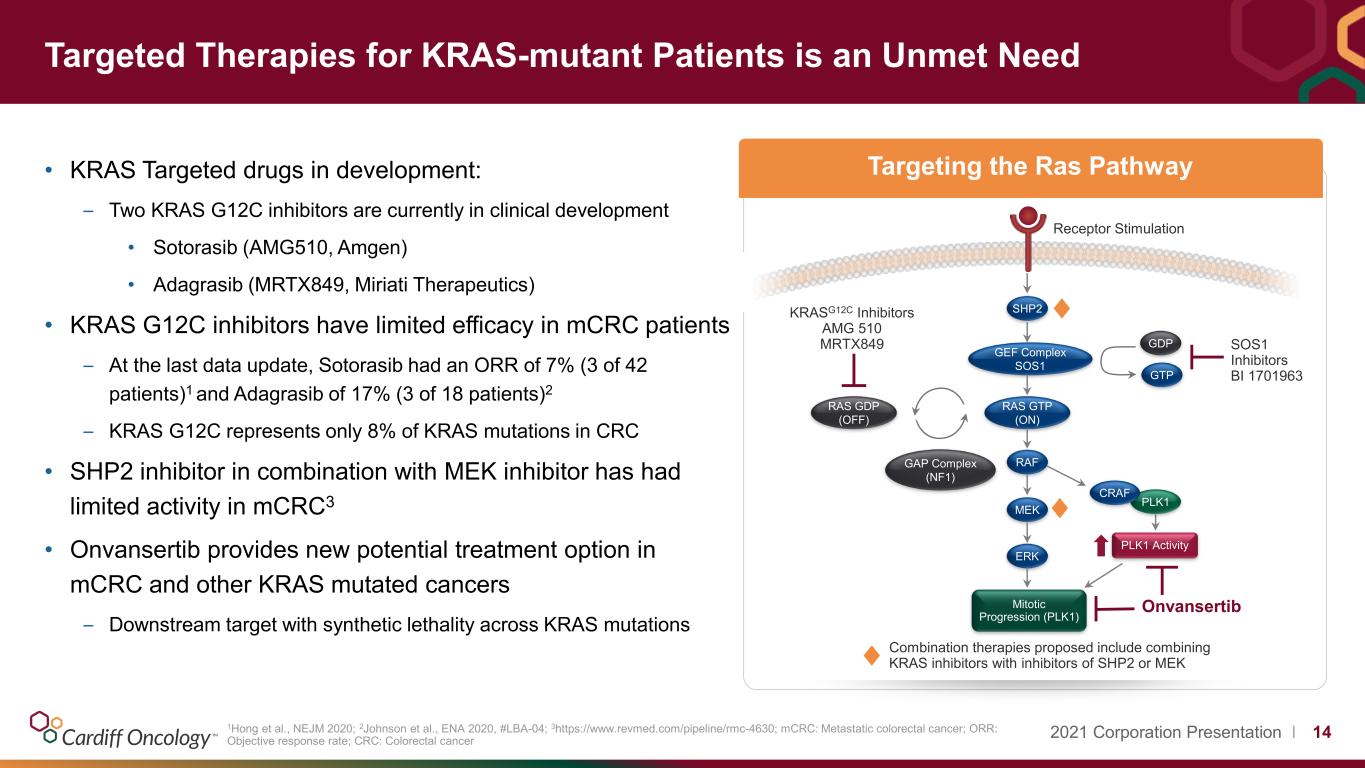
2021 Corporation Presentation I 14 Targeting the Ras Pathway Targeted Therapies for KRAS-mutant Patients is an Unmet Need 1Hong et al., NEJM 2020; 2Johnson et al., ENA 2020, #LBA-04; 3https://www.revmed.com/pipeline/rmc-4630; mCRC: Metastatic colorectal cancer; ORR: Objective response rate; CRC: Colorectal cancer • KRAS Targeted drugs in development: – Two KRAS G12C inhibitors are currently in clinical development • Sotorasib (AMG510, Amgen) • Adagrasib (MRTX849, Miriati Therapeutics) • KRAS G12C inhibitors have limited efficacy in mCRC patients – At the last data update, Sotorasib had an ORR of 7% (3 of 42 patients)1 and Adagrasib of 17% (3 of 18 patients)2 – KRAS G12C represents only 8% of KRAS mutations in CRC • SHP2 inhibitor in combination with MEK inhibitor has had limited activity in mCRC3 • Onvansertib provides new potential treatment option in mCRC and other KRAS mutated cancers – Downstream target with synthetic lethality across KRAS mutations Receptor Stimulation SHP2 GEF Complex SOS1 RAS GTP (ON) RAF MEK ERK GAP Complex (NF1) KRASG12C Inhibitors AMG 510 MRTX849 Combination therapies proposed include combining KRAS inhibitors with inhibitors of SHP2 or MEK GDP GTP SOS1 Inhibitors BI 1701963 RAS GDP (OFF) PLK1 Mitotic Progression (PLK1) PLK1 Activity CRAF Onvansertib
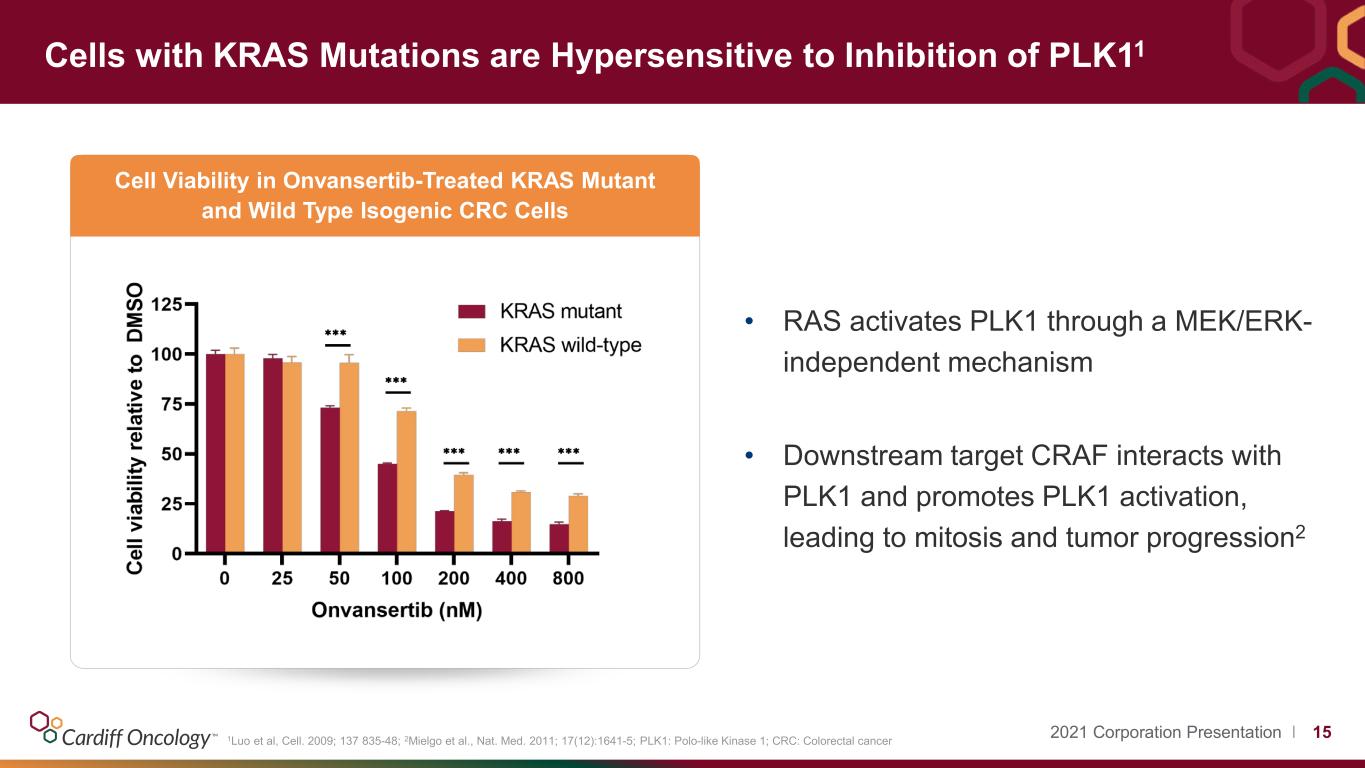
2021 Corporation Presentation I 15 Cells with KRAS Mutations are Hypersensitive to Inhibition of PLK11 1Luo et al, Cell. 2009; 137 835-48; 2Mielgo et al., Nat. Med. 2011; 17(12):1641-5; PLK1: Polo-like Kinase 1; CRC: Colorectal cancer • RAS activates PLK1 through a MEK/ERK- independent mechanism • Downstream target CRAF interacts with PLK1 and promotes PLK1 activation, leading to mitosis and tumor progression2 Cell Viability in Onvansertib-Treated KRAS Mutant and Wild Type Isogenic CRC Cells
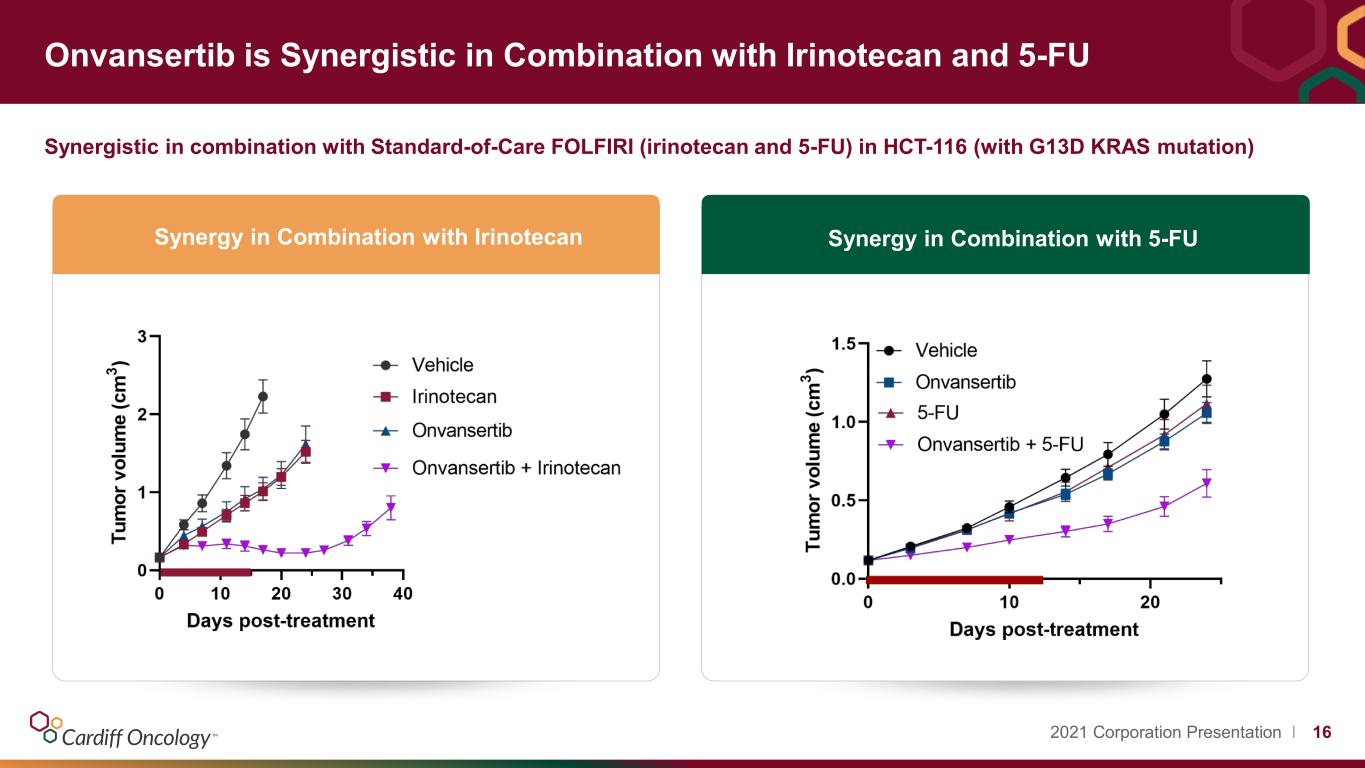
2021 Corporation Presentation I 16 Onvansertib is Synergistic in Combination with Irinotecan and 5-FU Synergistic in combination with Standard-of-Care FOLFIRI (irinotecan and 5-FU) in HCT-116 (with G13D KRAS mutation) Synergy in Combination with Irinotecan Synergy in Combination with 5-FU
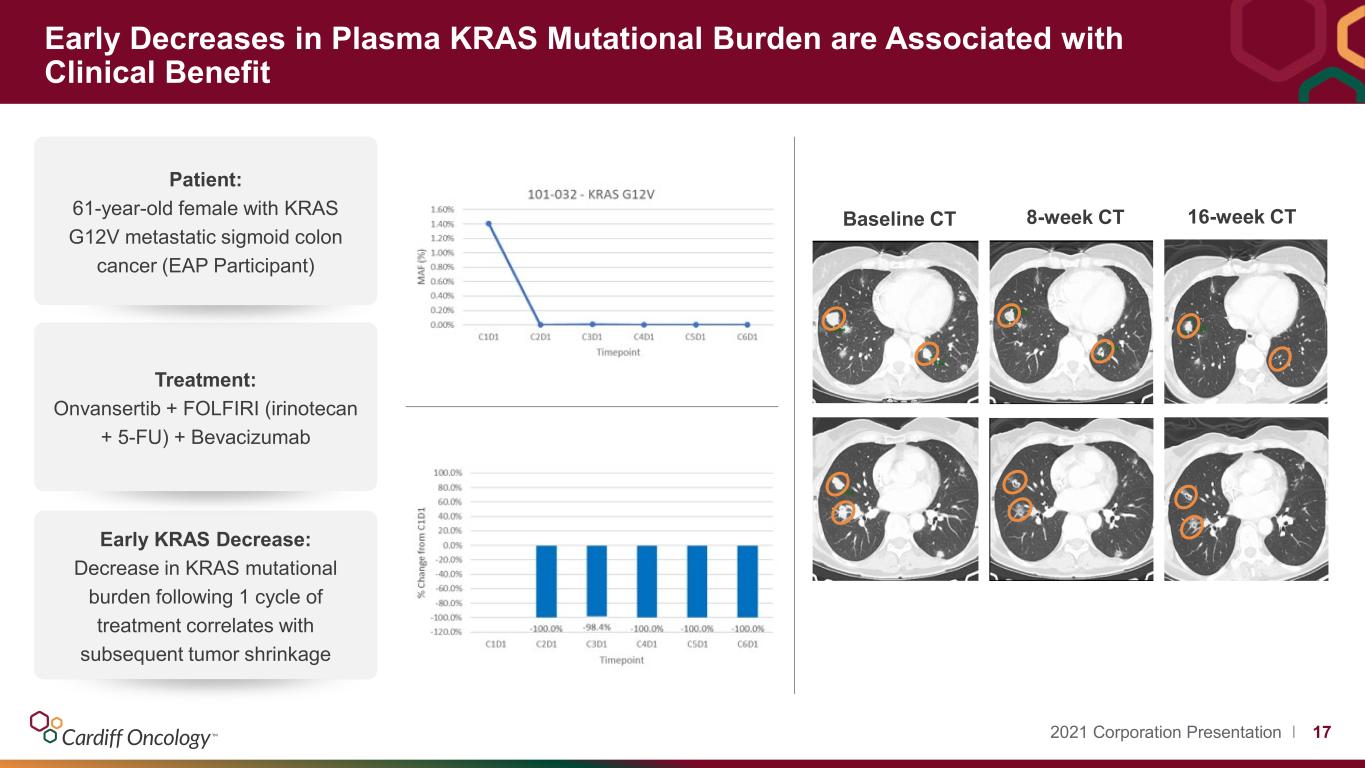
2021 Corporation Presentation I 17 Patient: 61-year-old female with KRAS G12V metastatic sigmoid colon cancer (EAP Participant) Treatment: Onvansertib + FOLFIRI (irinotecan + 5-FU) + Bevacizumab Early KRAS Decrease: Decrease in KRAS mutational burden following 1 cycle of treatment correlates with subsequent tumor shrinkage Early Decreases in Plasma KRAS Mutational Burden are Associated with Clinical Benefit Baseline CT 8-week CT 16-week CT Scan Scan Scan

Second-Line Treatment of KRAS-Mutated mCRC Phase 1b/2 open-label trial of onvansertib + FOLFIRI/bevacizumab Trial Sites: USC Norris Comprehensive Cancer Center; Mayo Clinics (Arizona, Minnesota, Florida), Kansas University Medical Center, CARTI Cancer Center, Inova Schar Cancer Institute Principal Investigator: Dr. Heinz-Josef Lenz
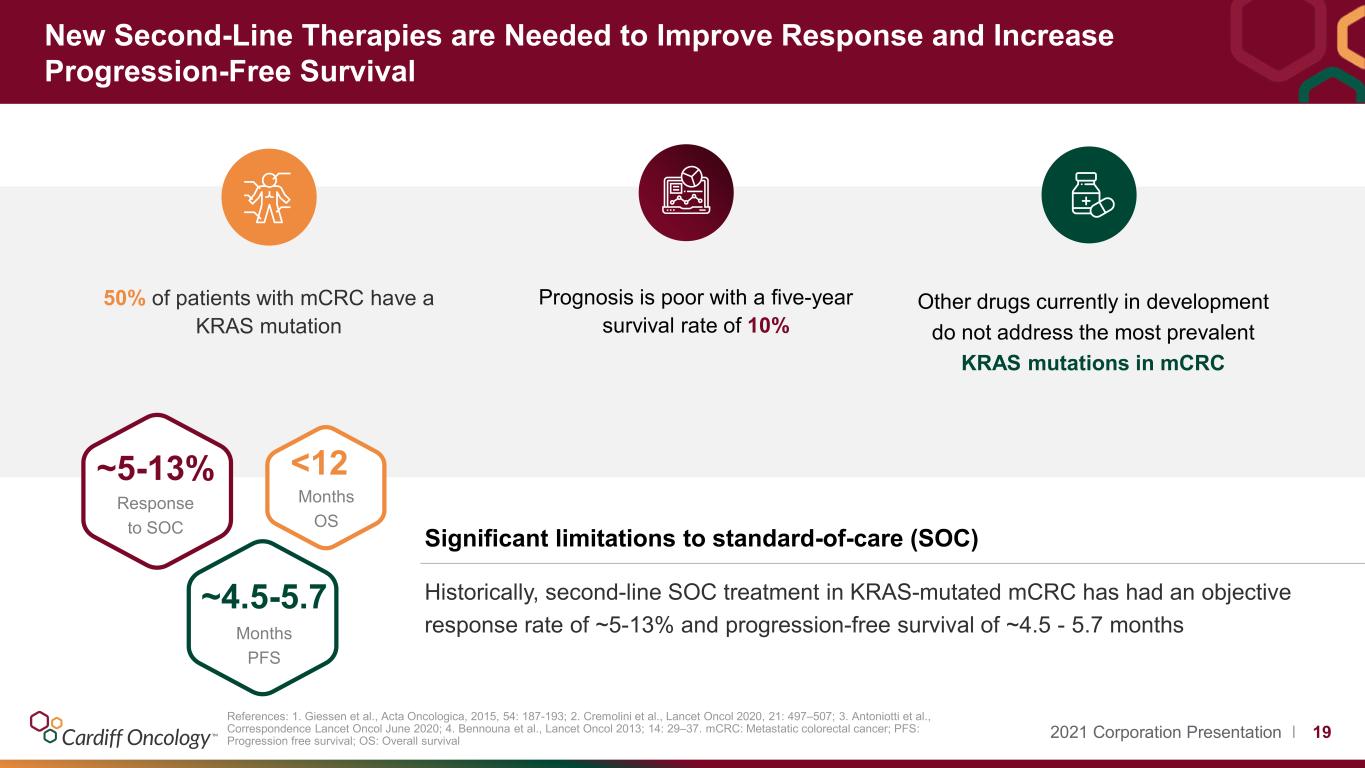
2021 Corporation Presentation I 19 50% of patients with mCRC have a KRAS mutation Prognosis is poor with a five-year survival rate of 10% Other drugs currently in development do not address the most prevalent KRAS mutations in mCRC Historically, second-line SOC treatment in KRAS-mutated mCRC has had an objective response rate of ~5-13% and progression-free survival of ~4.5 - 5.7 months Significant limitations to standard-of-care (SOC) New Second-Line Therapies are Needed to Improve Response and Increase Progression-Free Survival ~5-13% Response to SOC ~4.5-5.7 Months PFS <12 Months OS References: 1. Giessen et al., Acta Oncologica, 2015, 54: 187-193; 2. Cremolini et al., Lancet Oncol 2020, 21: 497–507; 3. Antoniotti et al., Correspondence Lancet Oncol June 2020; 4. Bennouna et al., Lancet Oncol 2013; 14: 29–37. mCRC: Metastatic colorectal cancer; PFS: Progression free survival; OS: Overall survival
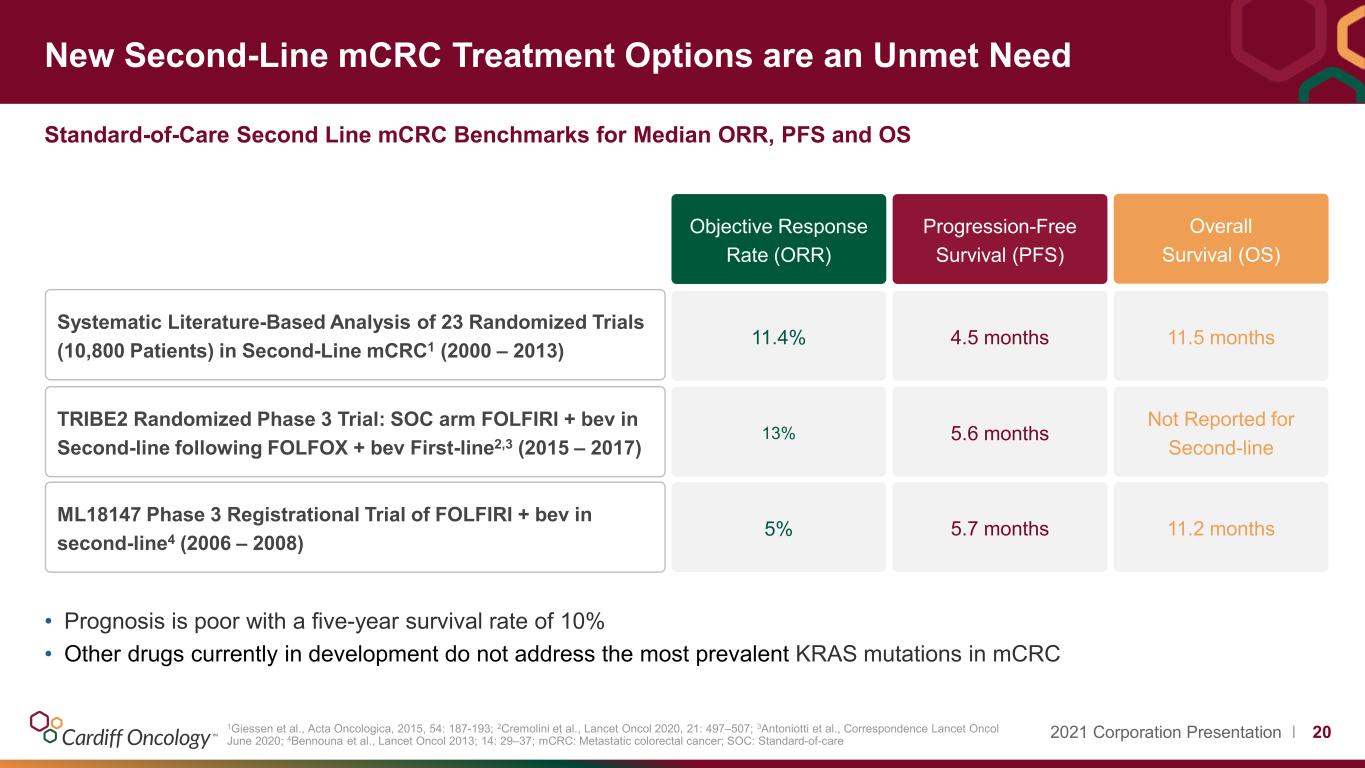
2021 Corporation Presentation I 20 13% 11.5 months Not Reported for Second-line 11.2 months Overall Survival (OS) 4.5 months 5.6 months 5.7 months Progression-Free Survival (PFS) 11.4% 5% Objective Response Rate (ORR) Systematic Literature-Based Analysis of 23 Randomized Trials (10,800 Patients) in Second-Line mCRC1 (2000 – 2013) TRIBE2 Randomized Phase 3 Trial: SOC arm FOLFIRI + bev in Second-line following FOLFOX + bev First-line2,3 (2015 – 2017) ML18147 Phase 3 Registrational Trial of FOLFIRI + bev in second-line4 (2006 – 2008) 1Giessen et al., Acta Oncologica, 2015, 54: 187-193; 2Cremolini et al., Lancet Oncol 2020, 21: 497–507; 3Antoniotti et al., Correspondence Lancet Oncol June 2020; 4Bennouna et al., Lancet Oncol 2013; 14: 29–37; mCRC: Metastatic colorectal cancer; SOC: Standard-of-care Standard-of-Care Second Line mCRC Benchmarks for Median ORR, PFS and OS New Second-Line mCRC Treatment Options are an Unmet Need • Prognosis is poor with a five-year survival rate of 10% • Other drugs currently in development do not address the most prevalent KRAS mutations in mCRC
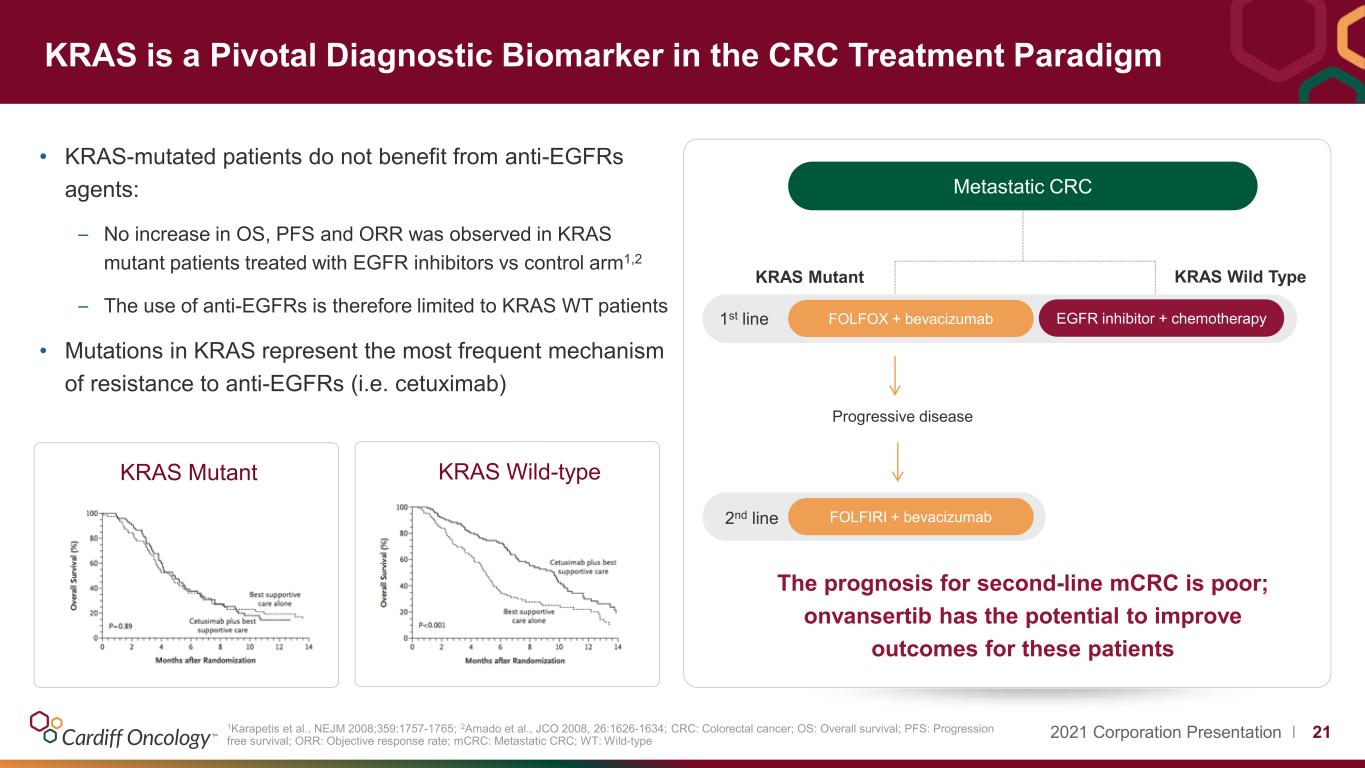
2021 Corporation Presentation I 211Karapetis et al., NEJM 2008;359:1757-1765; 2Amado et al., JCO 2008, 26:1626-1634; CRC: Colorectal cancer; OS: Overall survival; PFS: Progression free survival; ORR: Objective response rate; mCRC: Metastatic CRC; WT: Wild-type KRAS is a Pivotal Diagnostic Biomarker in the CRC Treatment Paradigm • KRAS-mutated patients do not benefit from anti-EGFRs agents: – No increase in OS, PFS and ORR was observed in KRAS mutant patients treated with EGFR inhibitors vs control arm1,2 – The use of anti-EGFRs is therefore limited to KRAS WT patients • Mutations in KRAS represent the most frequent mechanism of resistance to anti-EGFRs (i.e. cetuximab) KRAS Wild Type Progressive disease 1st line KRAS Mutant The prognosis for second-line mCRC is poor; onvansertib has the potential to improve outcomes for these patients KRAS Wild-typeKRAS Mutant Metastatic CRC FOLFOX + bevacizumab EGFR inhibitor + chemotherapy 2nd line FOLFIRI + bevacizumab

2021 Corporation Presentation I 22 Trial Design: Phase 1b/2 Open Label Study of Onvansertib + FOLFIRI/bevacizumab Trial Design Efficacy Endpoints • Objective response rate (ORR) in patients who receive ≥1 cycle of treatment • Progression-free survival (PFS) and duration of response (DOR) • Decreases in KRAS mutational burden and response to treatment 1 CYCLE = 28 Days Treatment Course = 14 Days Treatment Course = 14 Days 2 3 4 5 6 - 141 2 3 4 5 6 - 141 Onvansertib Onvansertib FOLFIRI + bevacizumab FOLFIRI + bevacizumab • 20% (5/26 patients) ORR • ≥ 6 months median PFS Criteria for Clinical Proof of Concept
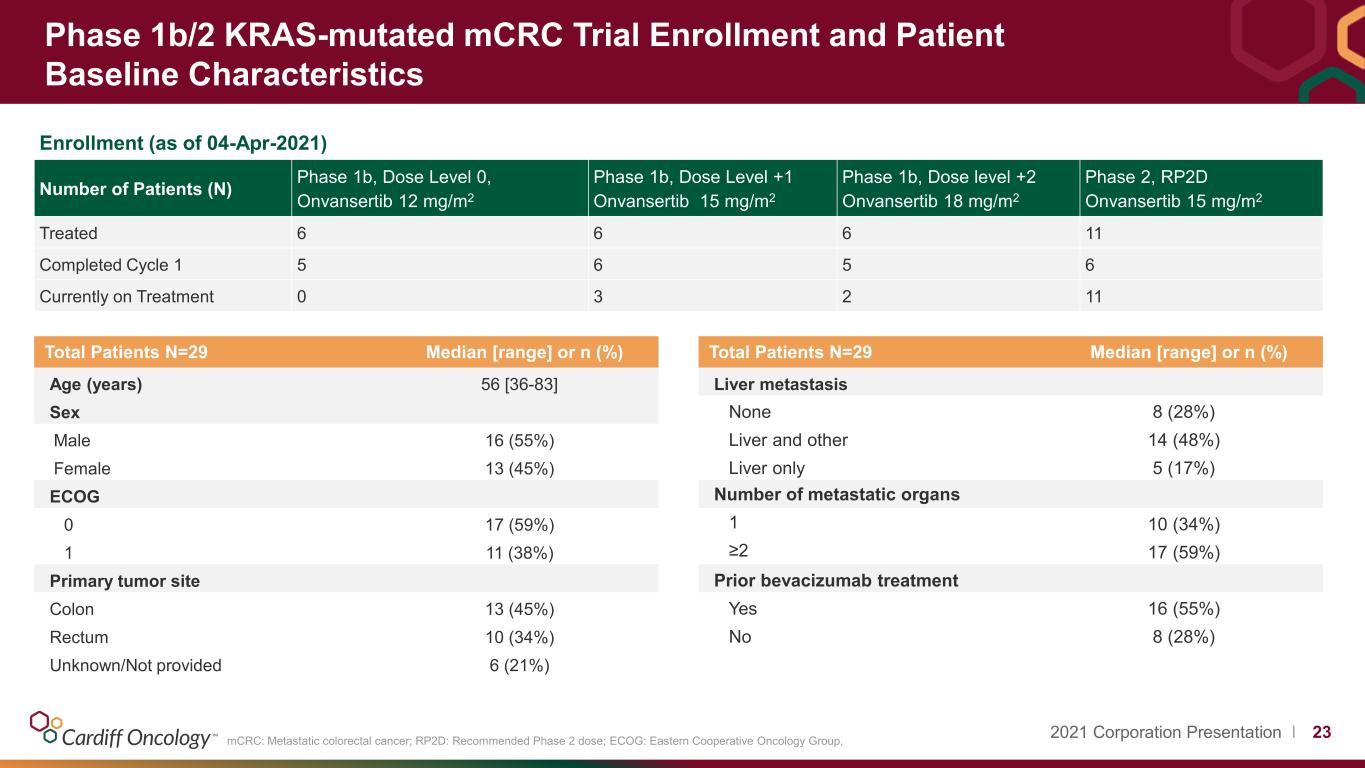
2021 Corporation Presentation I 23mCRC: Metastatic colorectal cancer; RP2D: Recommended Phase 2 dose; ECOG: Eastern Cooperative Oncology Group, Phase 1b/2 KRAS-mutated mCRC Trial Enrollment and Patient Baseline Characteristics Enrollment (as of 04-Apr-2021) Number of Patients (N) Phase 1b, Dose Level 0, Onvansertib 12 mg/m2 Phase 1b, Dose Level +1 Onvansertib 15 mg/m2 Phase 1b, Dose level +2 Onvansertib 18 mg/m2 Phase 2, RP2D Onvansertib 15 mg/m2 Treated 6 6 6 11 Completed Cycle 1 5 6 5 6 Currently on Treatment 0 3 2 11 Total Patients N=29 Median [range] or n (%) Age (years) 56 [36-83] Sex Male 16 (55%) Female 13 (45%) ECOG 0 17 (59%) 1 11 (38%) Primary tumor site Colon 13 (45%) Rectum 10 (34%) Unknown/Not provided 6 (21%) Total Patients N=29 Median [range] or n (%) Liver metastasis None 8 (28%) Liver and other 14 (48%) Liver only 5 (17%) Number of metastatic organs 1 10 (34%) ≥2 17 (59%) Prior bevacizumab treatment Yes 16 (55%) No 8 (28%)
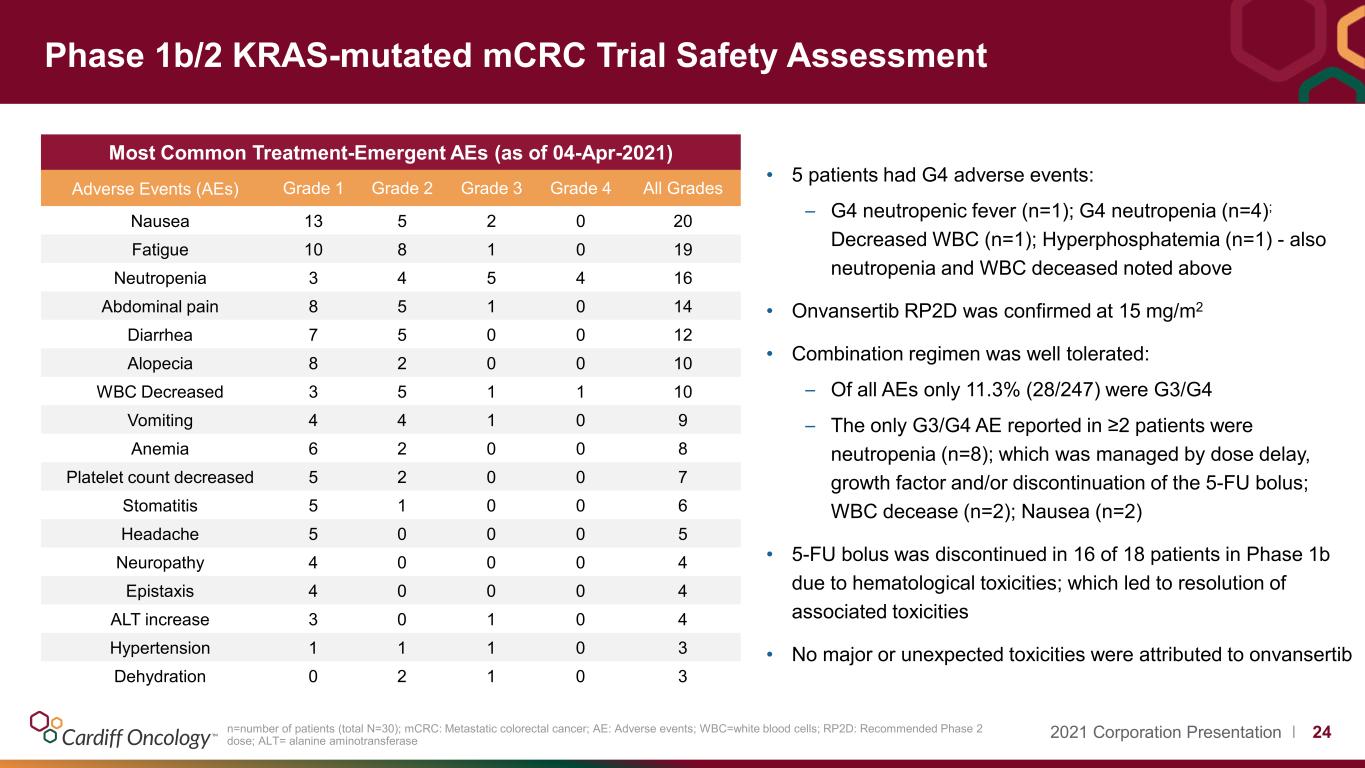
2021 Corporation Presentation I 24n=number of patients (total N=30); mCRC: Metastatic colorectal cancer; AE: Adverse events; WBC=white blood cells; RP2D: Recommended Phase 2 dose; ALT= alanine aminotransferase Phase 1b/2 KRAS-mutated mCRC Trial Safety Assessment Most Common Treatment-Emergent AEs (as of 04-Apr-2021) Adverse Events (AEs) Grade 1 Grade 2 Grade 3 Grade 4 All Grades Nausea 13 5 2 0 20 Fatigue 10 8 1 0 19 Neutropenia 3 4 5 4 16 Abdominal pain 8 5 1 0 14 Diarrhea 7 5 0 0 12 Alopecia 8 2 0 0 10 WBC Decreased 3 5 1 1 10 Vomiting 4 4 1 0 9 Anemia 6 2 0 0 8 Platelet count decreased 5 2 0 0 7 Stomatitis 5 1 0 0 6 Headache 5 0 0 0 5 Neuropathy 4 0 0 0 4 Epistaxis 4 0 0 0 4 ALT increase 3 0 1 0 4 Hypertension 1 1 1 0 3 Dehydration 0 2 1 0 3 • 5 patients had G4 adverse events: – G4 neutropenic fever (n=1); G4 neutropenia (n=4); Decreased WBC (n=1); Hyperphosphatemia (n=1) - also neutropenia and WBC deceased noted above • Onvansertib RP2D was confirmed at 15 mg/m2 • Combination regimen was well tolerated: – Of all AEs only 11.3% (28/247) were G3/G4 – The only G3/G4 AE reported in ≥2 patients were neutropenia (n=8); which was managed by dose delay, growth factor and/or discontinuation of the 5-FU bolus; WBC decease (n=2); Nausea (n=2) • 5-FU bolus was discontinued in 16 of 18 patients in Phase 1b due to hematological toxicities; which led to resolution of associated toxicities • No major or unexpected toxicities were attributed to onvansertib
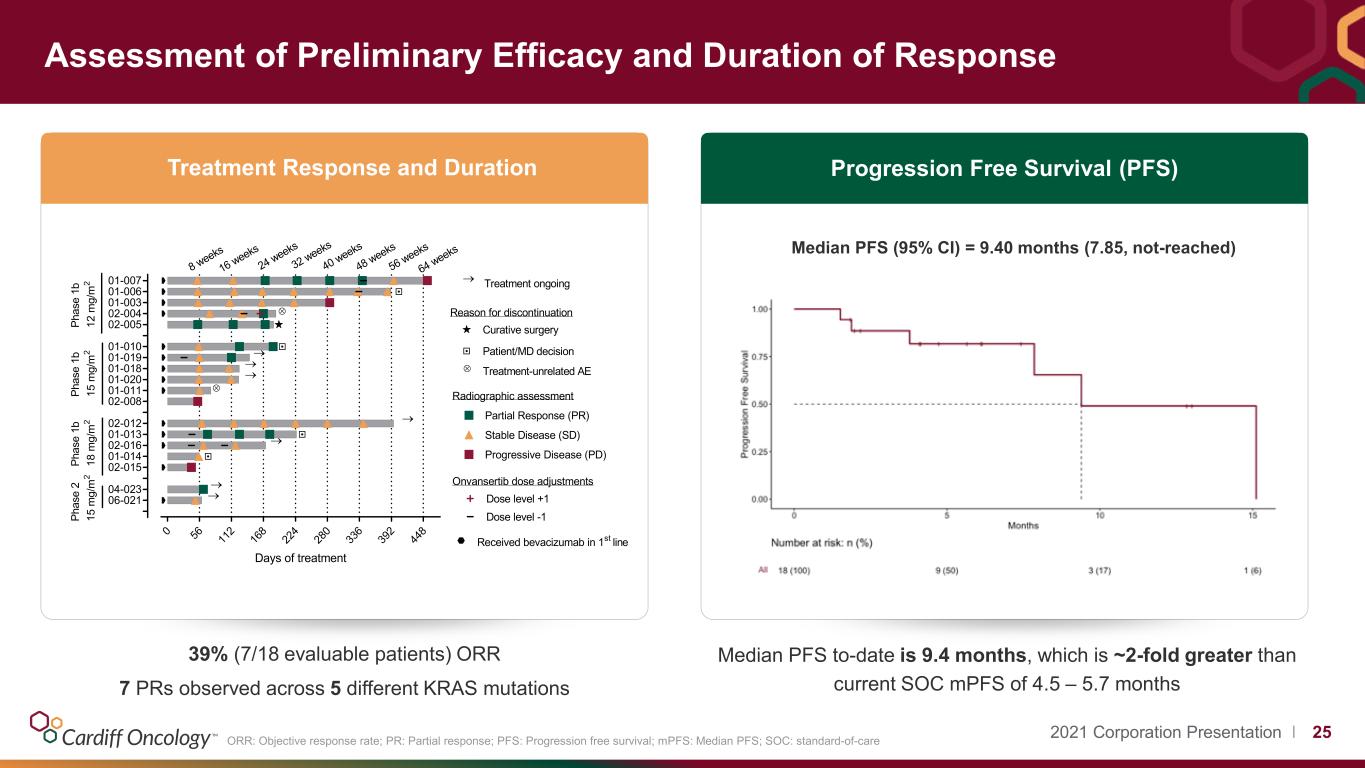
2021 Corporation Presentation I 25ORR: Objective response rate; PR: Partial response; PFS: Progression free survival; mPFS: Median PFS; SOC: standard-of-care Assessment of Preliminary Efficacy and Duration of Response 39% (7/18 evaluable patients) ORR 7 PRs observed across 5 different KRAS mutations Progression Free Survival (PFS)Treatment Response and Duration 0 56 11 2 16 8 22 4 28 0 33 6 39 2 44 8 06-021 04-023 02-015 01-014 02-016 01-013 02-012 02-008 01-011 01-020 01-018 01-019 01-010 02-005 02-004 01-003 01-006 01-007 ⊗ ⊗ → → → → → → → Days of treatment 8 w eek s 16 wee ks 32 wee ks Radiographic assessment Partial Response (PR) Stable Disease (SD) Progressive Disease (PD) P ha se 1 b 12 m g/ m 2 P ha se 1 b 15 m g/ m 2 P ha se 1 b 18 m g/ m 2 40 wee ks 48 wee ks Treatment ongoing→ Curative surgery Patient/MD decision Reason for discontinuation Treatment-unrelated AE⊗ 56 wee ks Received bevacizumab in 1st line Dose level +1 Dose level -1 Onvansertib dose adjustments 64 wee ks 24 wee ks P ha se 2 15 m g/ m 2 Median PFS to-date is 9.4 months, which is ~2-fold greater than current SOC mPFS of 4.5 – 5.7 months Median PFS (95% CI) = 9.40 months (7.85, not-reached)
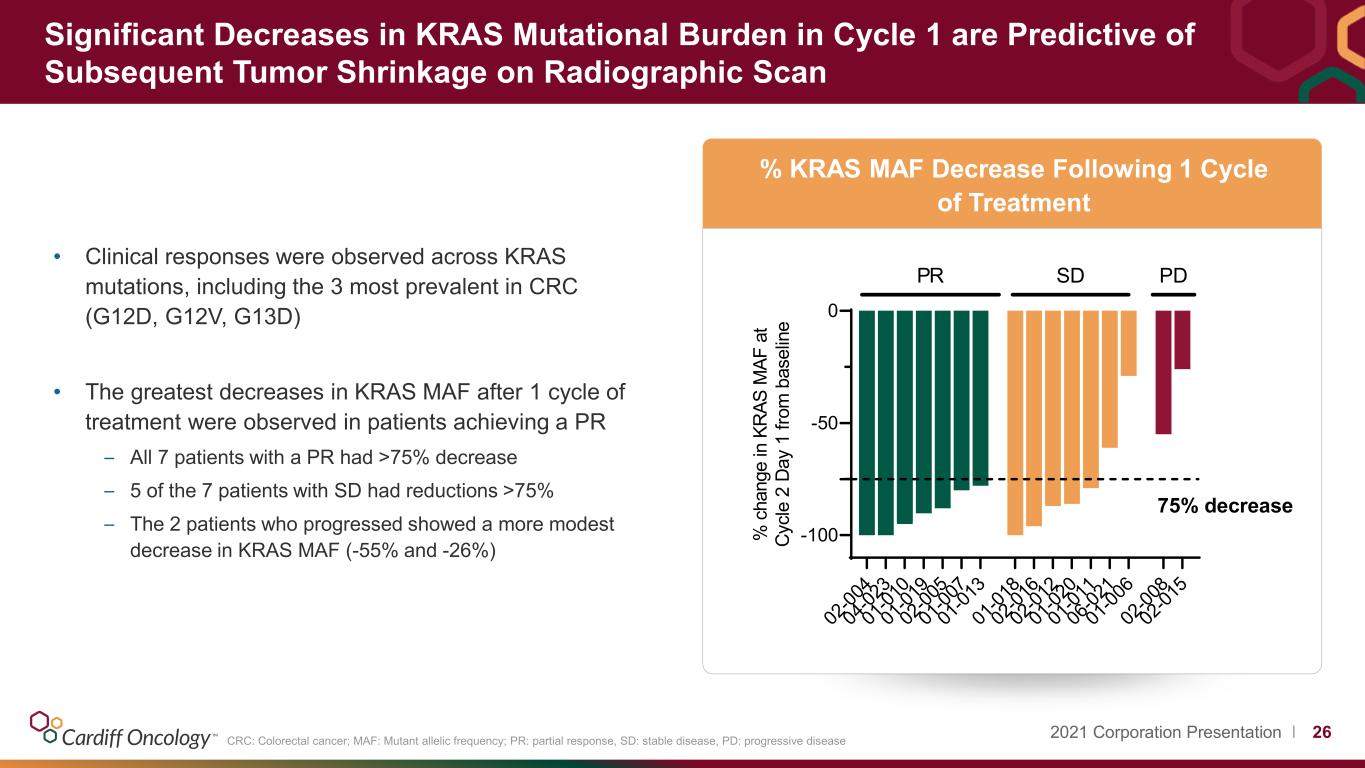
2021 Corporation Presentation I 26 % KRAS MAF Decrease Following 1 Cycle of Treatment Significant Decreases in KRAS Mutational Burden in Cycle 1 are Predictive of Subsequent Tumor Shrinkage on Radiographic Scan • Clinical responses were observed across KRAS mutations, including the 3 most prevalent in CRC (G12D, G12V, G13D) • The greatest decreases in KRAS MAF after 1 cycle of treatment were observed in patients achieving a PR – All 7 patients with a PR had >75% decrease – 5 of the 7 patients with SD had reductions >75% – The 2 patients who progressed showed a more modest decrease in KRAS MAF (-55% and -26%) 02 -0 04 04 -0 23 01 -0 10 01 -0 19 02 -0 05 01 -0 07 01 -0 13 01 -0 18 02 -0 16 02 -0 12 01 -0 20 01 -0 11 06 -0 21 01 -0 06 02 -0 08 02 -0 15 -100 -50 0 % c ha ng e in K R A S M A F at C yc le 2 D ay 1 fr om b as el in e PR SD PD 75% decrease CRC: Colorectal cancer; MAF: Mutant allelic frequency; PR: partial response, SD: stable disease, PD: progressive disease

2021 Corporation Presentation I 27DLT: Dose-limiting toxicity Patient Overview: 83-year-old woman with KRAS G12D metastatic colon cancer Phase 1b/2 Trial Patient Case Report – Patient 01-019 Background Additional Details C1D15 – G4 neutropenia (DLT); treatment was held C3D1 – G3 neutropenia; treatment was held C2D1 – 5-FU bolus eliminated C3D15 – Dose level reduction (-1) for irinotecan and 5-FU Oxaliplatin + 5-FU Treatment History 5-FU + Bev 5-FU FOLFIRI + Bev + onvansertib Dec 2018 – Jul 2019 Jul 2019 – Dec 2019 Dec 2019 – Sept 2020 Nov 2020 – TROV-054 Jul 2020: Disease Progression
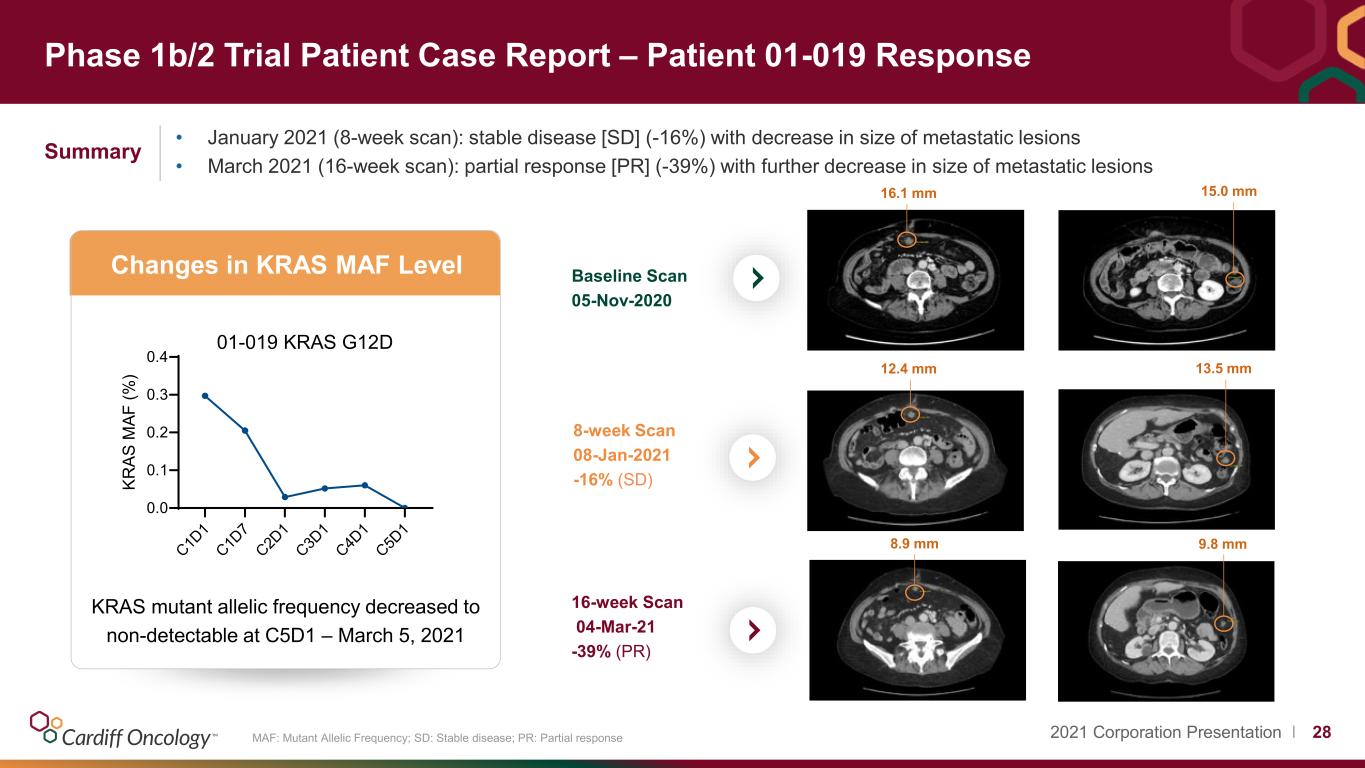
2021 Corporation Presentation I 28MAF: Mutant Allelic Frequency; SD: Stable disease; PR: Partial response Summary Phase 1b/2 Trial Patient Case Report – Patient 01-019 Response • January 2021 (8-week scan): stable disease [SD] (-16%) with decrease in size of metastatic lesions • March 2021 (16-week scan): partial response [PR] (-39%) with further decrease in size of metastatic lesions Baseline Scan 05-Nov-2020 16-week Scan 04-Mar-21 -39% (PR) 8-week Scan 08-Jan-2021 -16% (SD) Changes in KRAS MAF Level KRAS mutant allelic frequency decreased to non-detectable at C5D1 – March 5, 2021 C1 D1 C1 D7 C2 D1 C3 D1 C4 D1 C5 D1 0.0 0.1 0.2 0.3 0.4 01-019 KRAS G12D K R A S M A F (% ) 12.4 mm 13.5 mm 8.9 mm 9.8 mm 16.1 mm 15.0 mm
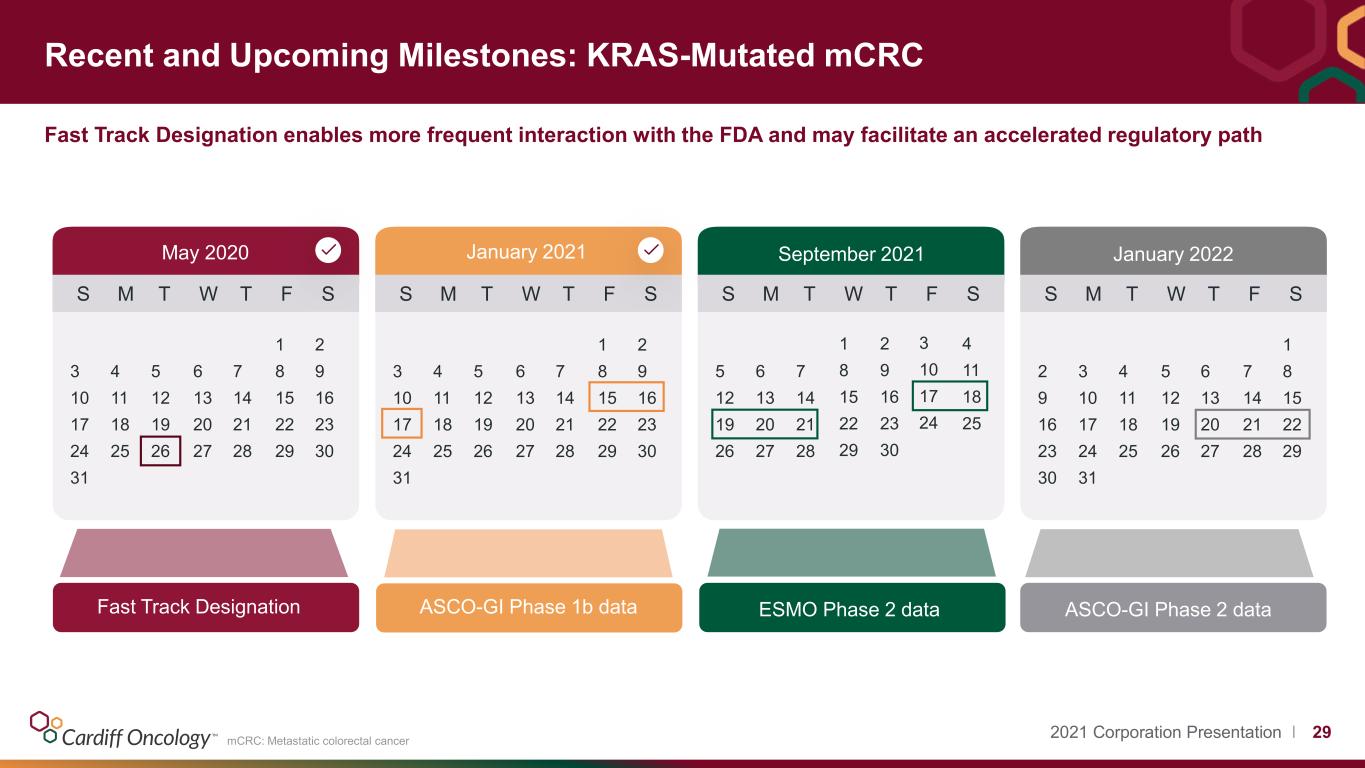
2021 Corporation Presentation I 29 3 10 17 24 31 4 11 18 25 5 12 19 26 6 13 20 27 7 14 21 28 1 8 15 22 29 2 9 16 23 30 S May 2020 M T W T F S 3 10 17 24 31 4 11 18 25 5 12 19 26 6 13 20 27 7 14 21 28 1 8 15 22 29 2 9 16 23 30 S January 2021 M T W T F S 5 12 19 26 6 13 20 27 7 14 21 28 1 8 15 22 29 4 11 18 25 S September 2021 M T W T F S 2 9 16 23 30 3 10 17 24 31 4 11 18 25 5 12 19 26 6 13 20 27 7 14 21 28 1 8 15 22 29 S January 2022 M T W T F S mCRC: Metastatic colorectal cancer Fast Track Designation enables more frequent interaction with the FDA and may facilitate an accelerated regulatory path Recent and Upcoming Milestones: KRAS-Mutated mCRC ESMO Phase 2 dataFast Track Designation ASCO-GI Phase 1b data ASCO-GI Phase 2 data 2 9 16 23 30 3 10 17 24
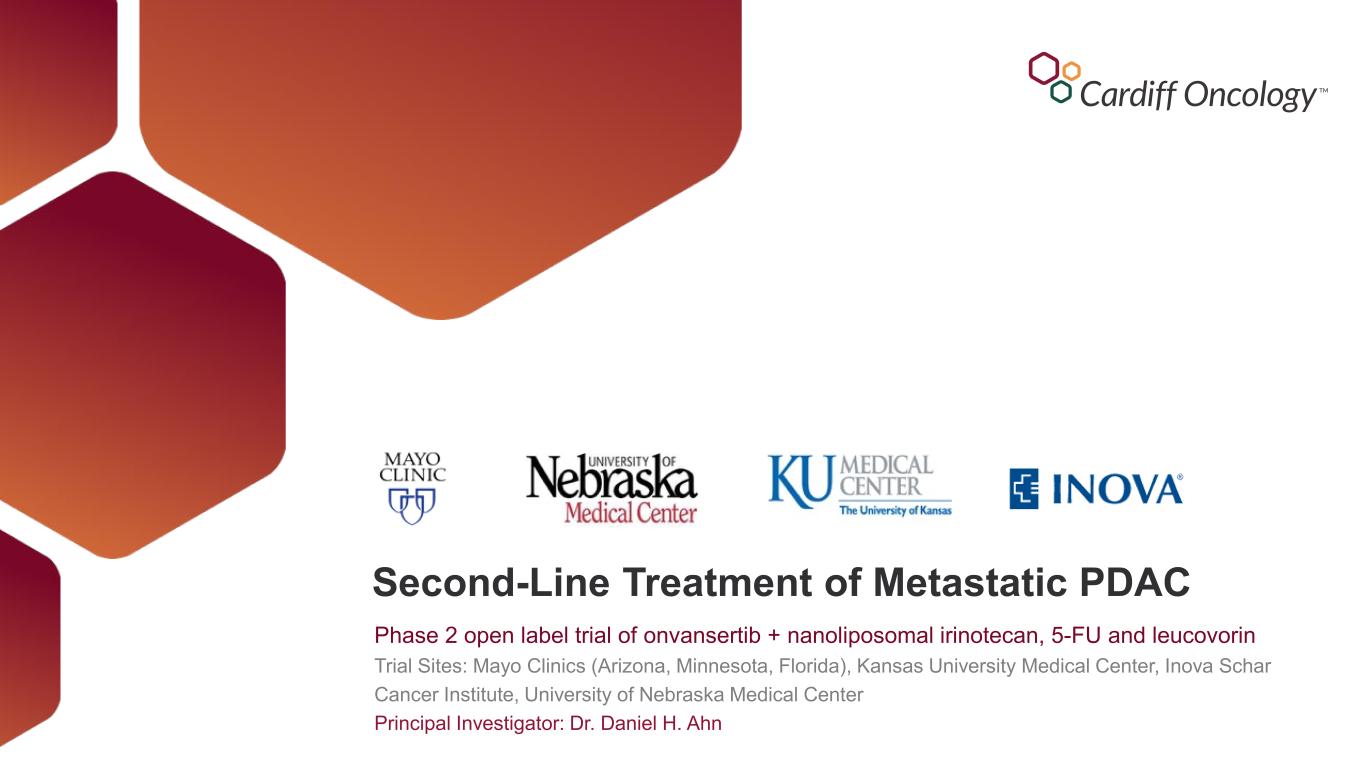
Second-Line Treatment of Metastatic PDAC Phase 2 open label trial of onvansertib + nanoliposomal irinotecan, 5-FU and leucovorin Trial Sites: Mayo Clinics (Arizona, Minnesota, Florida), Kansas University Medical Center, Inova Schar Cancer Institute, University of Nebraska Medical Center Principal Investigator: Dr. Daniel H. Ahn
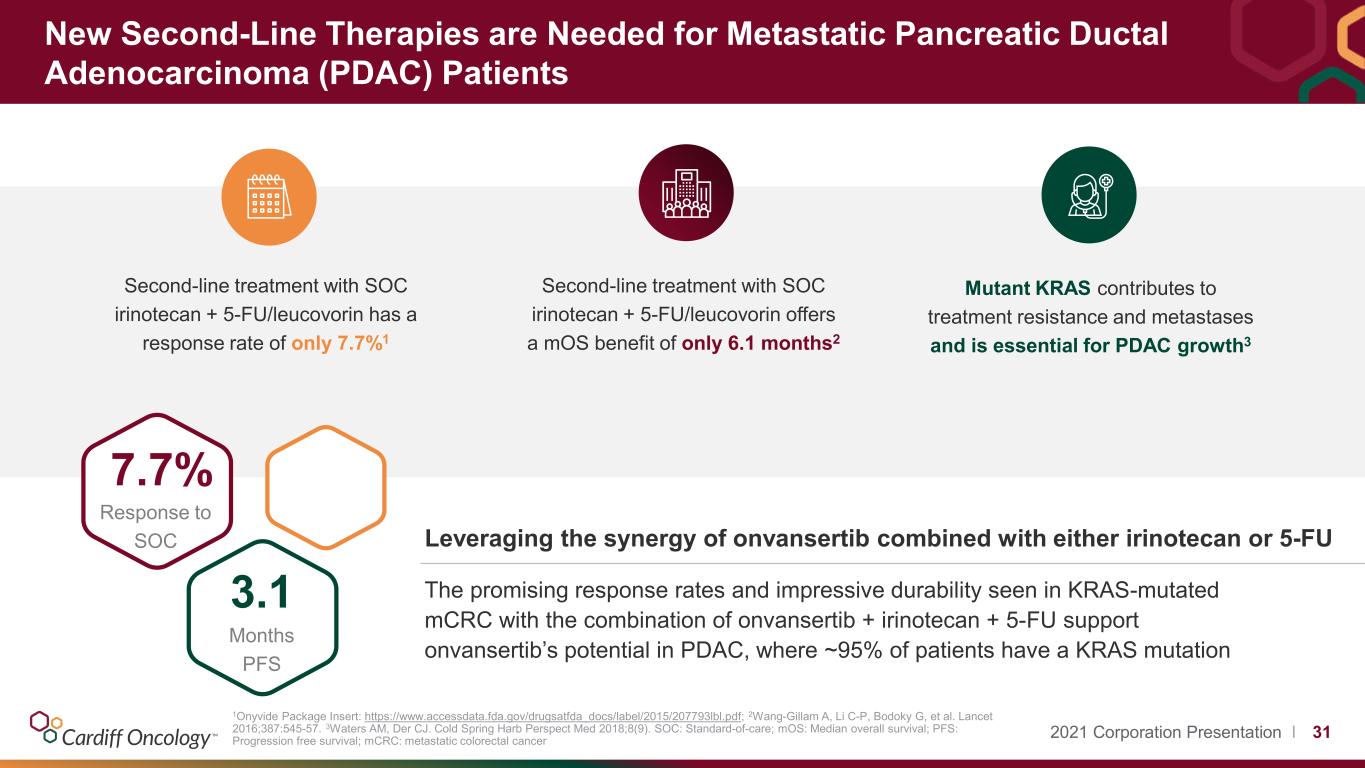
2021 Corporation Presentation I 31 1Onyvide Package Insert: https://www.accessdata.fda.gov/drugsatfda_docs/label/2015/207793lbl.pdf; 2Wang-Gillam A, Li C-P, Bodoky G, et al. Lancet 2016;387:545-57. 3Waters AM, Der CJ. Cold Spring Harb Perspect Med 2018;8(9). SOC: Standard-of-care; mOS: Median overall survival; PFS: Progression free survival; mCRC: metastatic colorectal cancer The promising response rates and impressive durability seen in KRAS-mutated mCRC with the combination of onvansertib + irinotecan + 5-FU support onvansertib’s potential in PDAC, where ~95% of patients have a KRAS mutation Leveraging the synergy of onvansertib combined with either irinotecan or 5-FU New Second-Line Therapies are Needed for Metastatic Pancreatic Ductal Adenocarcinoma (PDAC) Patients Second-line treatment with SOC irinotecan + 5-FU/leucovorin offers a mOS benefit of only 6.1 months2 Mutant KRAS contributes to treatment resistance and metastases and is essential for PDAC growth3 Second-line treatment with SOC irinotecan + 5-FU/leucovorin has a response rate of only 7.7%1 Response to SOC 7.7% 3.1 Months PFS

2021 Corporation Presentation I 32PDAC: Pancreatic ductal adenocarcinoma Trial Design: Phase 2 Open Label Study of Onvansertib + Nanoliposomal Irinotecan + 5-FU in Metastatic PDAC Trial Design (~45 patients): Eligibility Criteria • Prior abraxane/gemcitabine and no prior irinotecan, nanoliposomal irinotecan or investigational PLK1 inhibitor Primary Efficacy Endpoint • Objective response rate (ORR) 1 CYCLE = 14 Days Treatment Course (Days) Nanoliposomal Irinotecan (nal-IRI) + 5-FU • 20% (8/39) patients) Objective Response Rate Criteria for Clinical Proof of Concept 3 5 7 9 11 - 141 8642 10 Onvansertib 12 mg/m2 Onvansertib to be administered on Days 1-10 (12 mg/m2) based on safety lead-in of 6 patients (with option to dose 15 mg/m2 on Days 1-5)
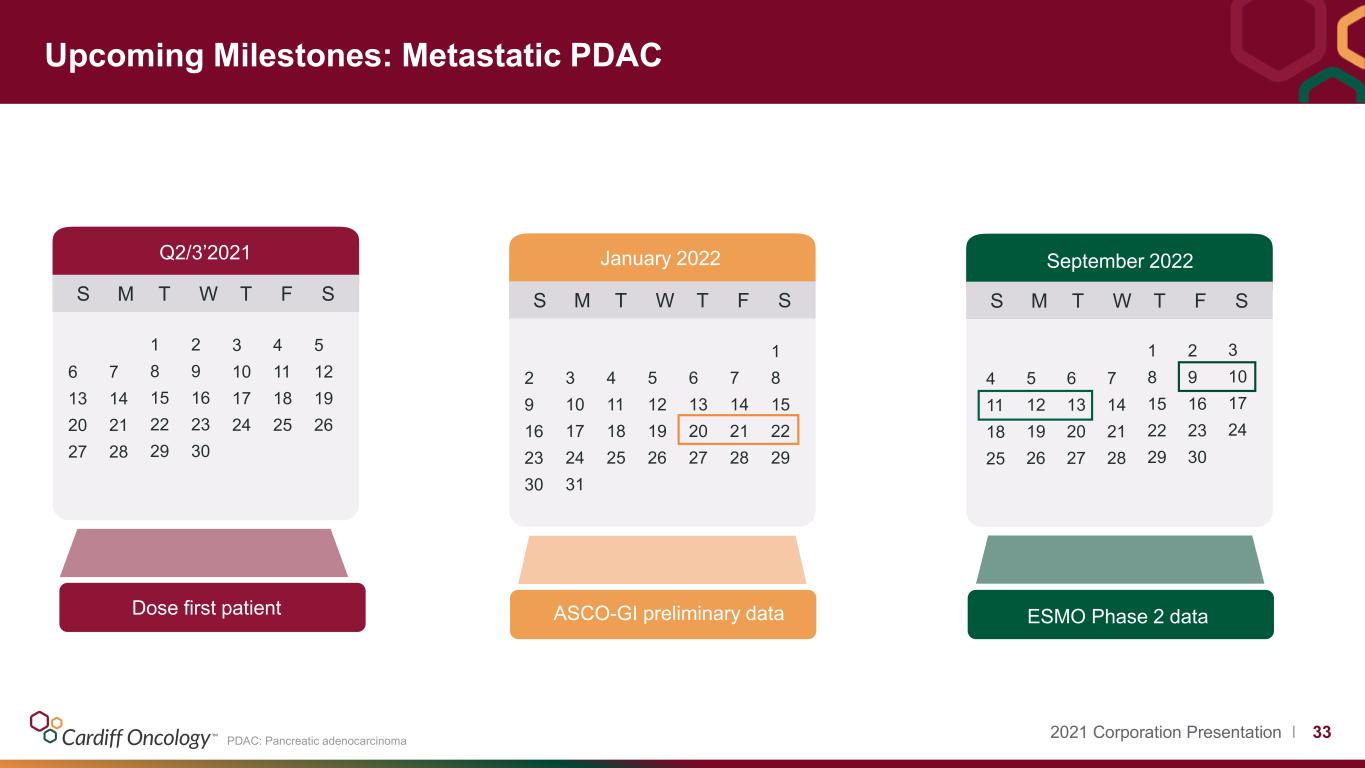
2021 Corporation Presentation I 33PDAC: Pancreatic adenocarcinoma Upcoming Milestones: Metastatic PDAC S Q2/3’2021 M T W T F S Dose first patient 5 12 19 26 6 13 20 27 7 14 21 28 1 8 15 22 29 S September 2022 M T W T F S ESMO Phase 2 data 2 9 16 23 30 3 10 17 24 4 11 18 25 3 10 17 24 31 4 11 18 25 5 12 19 26 6 13 20 27 7 14 21 28 1 8 15 22 29 S January 2022 M T W T F S ASCO-GI preliminary data 2 9 16 23 30 1 8 15 22 29 2 9 16 23 30 3 10 17 24 4 11 18 25 5 12 19 26 6 13 20 27 7 14 21 28
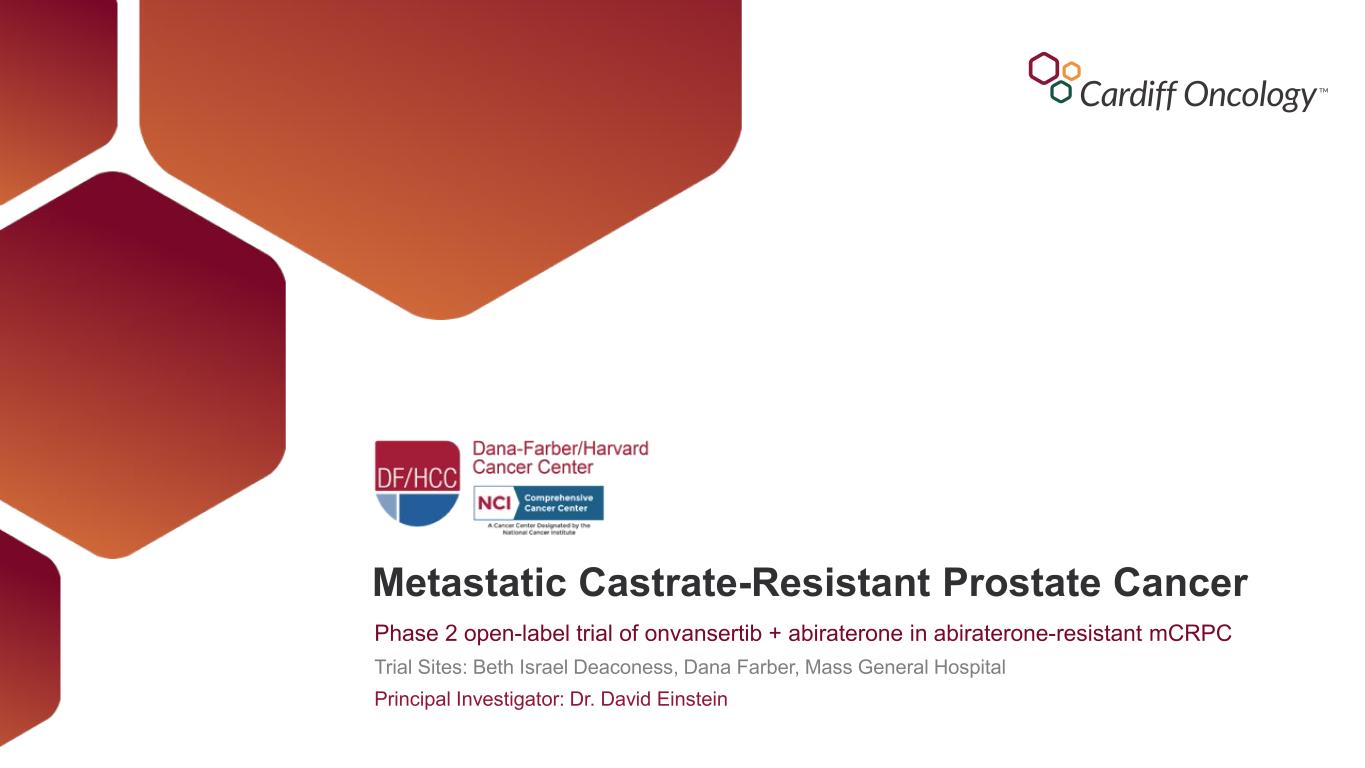
Metastatic Castrate-Resistant Prostate Cancer Phase 2 open-label trial of onvansertib + abiraterone in abiraterone-resistant mCRPC Trial Sites: Beth Israel Deaconess, Dana Farber, Mass General Hospital Principal Investigator: Dr. David Einstein
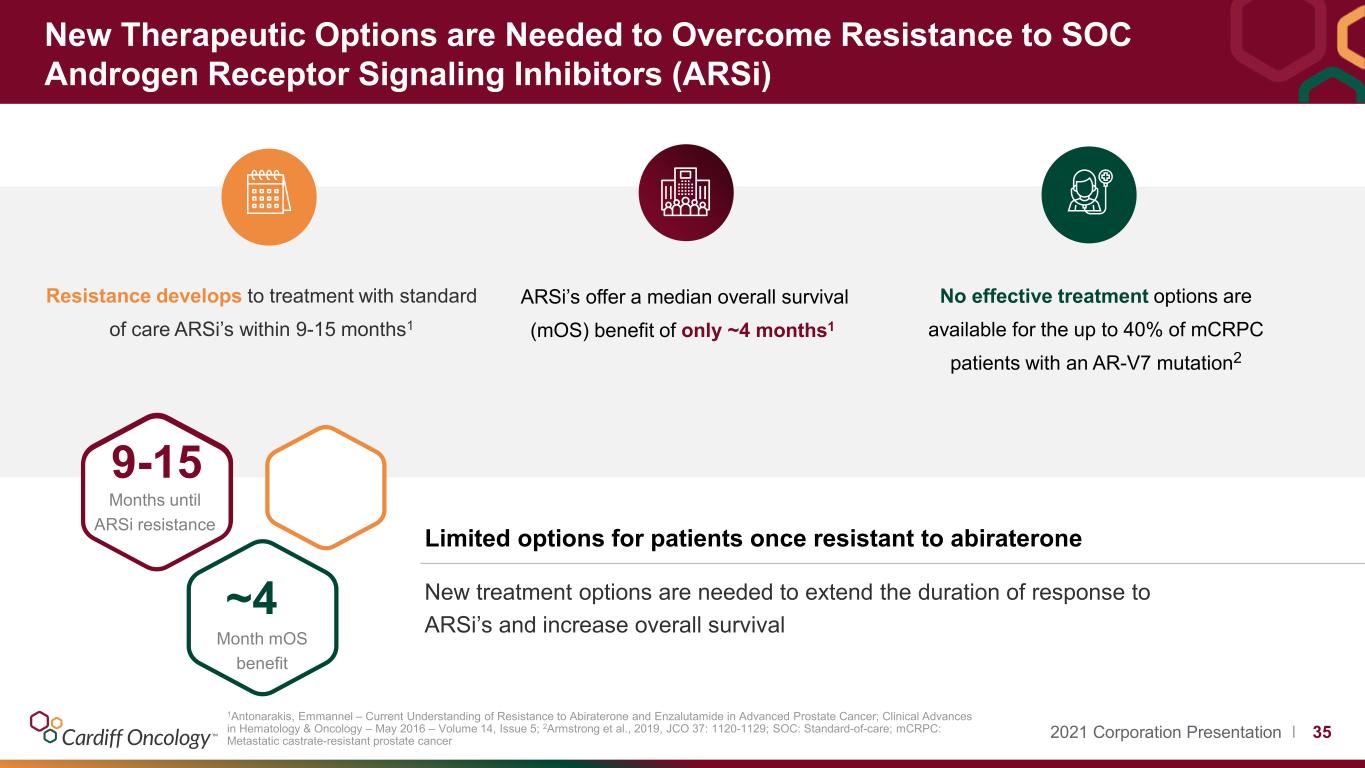
2021 Corporation Presentation I 35 New treatment options are needed to extend the duration of response to ARSi’s and increase overall survival Limited options for patients once resistant to abiraterone New Therapeutic Options are Needed to Overcome Resistance to SOC Androgen Receptor Signaling Inhibitors (ARSi) Resistance develops to treatment with standard of care ARSi’s within 9-15 months1 ARSi’s offer a median overall survival (mOS) benefit of only ~4 months1 No effective treatment options are available for the up to 40% of mCRPC patients with an AR-V7 mutation2 9-15 Months until ARSi resistance ~4 Month mOS benefit 1Antonarakis, Emmannel – Current Understanding of Resistance to Abiraterone and Enzalutamide in Advanced Prostate Cancer; Clinical Advances in Hematology & Oncology – May 2016 – Volume 14, Issue 5; 2Armstrong et al., 2019, JCO 37: 1120-1129; SOC: Standard-of-care; mCRPC: Metastatic castrate-resistant prostate cancer
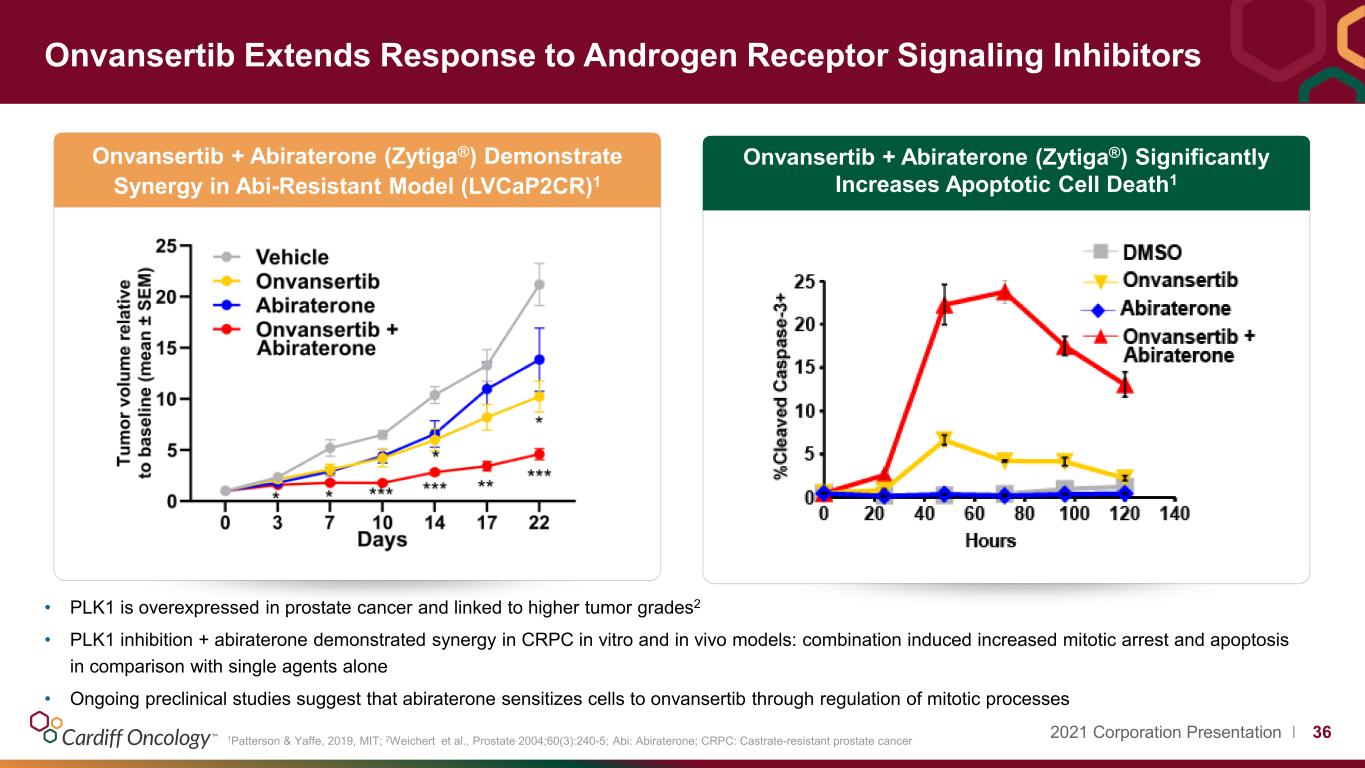
2021 Corporation Presentation I 361Patterson & Yaffe, 2019, MIT; 2Weichert et al., Prostate 2004;60(3):240-5; Abi: Abiraterone; CRPC: Castrate-resistant prostate cancer Onvansertib Extends Response to Androgen Receptor Signaling Inhibitors Onvansertib + Abiraterone (Zytiga®) Significantly Increases Apoptotic Cell Death1 Onvansertib + Abiraterone (Zytiga®) Demonstrate Synergy in Abi-Resistant Model (LVCaP2CR)1 • PLK1 is overexpressed in prostate cancer and linked to higher tumor grades2 • PLK1 inhibition + abiraterone demonstrated synergy in CRPC in vitro and in vivo models: combination induced increased mitotic arrest and apoptosis in comparison with single agents alone • Ongoing preclinical studies suggest that abiraterone sensitizes cells to onvansertib through regulation of mitotic processes
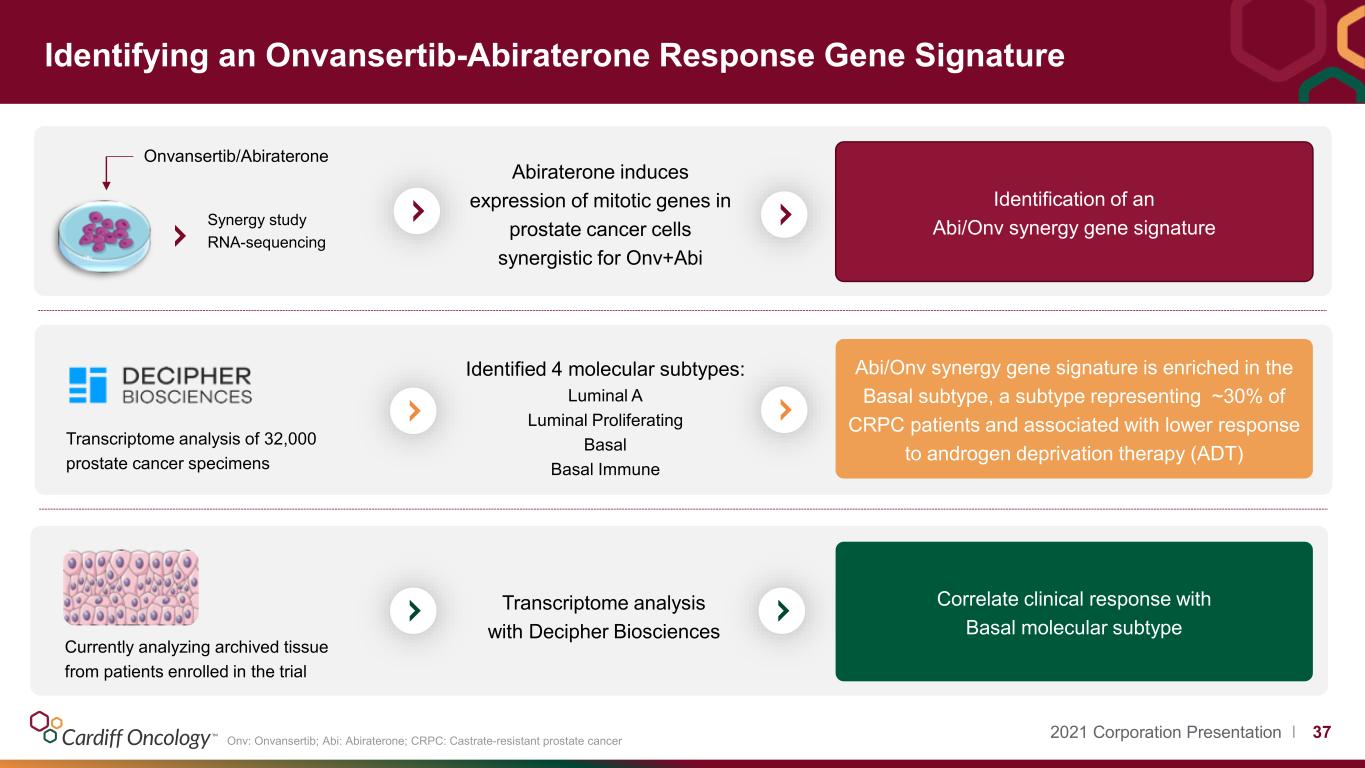
2021 Corporation Presentation I 37Onv: Onvansertib; Abi: Abiraterone; CRPC: Castrate-resistant prostate cancer Identifying an Onvansertib-Abiraterone Response Gene Signature Onvansertib/Abiraterone Abiraterone induces expression of mitotic genes in prostate cancer cells synergistic for Onv+Abi Synergy study RNA-sequencing Identified 4 molecular subtypes: Luminal A Luminal Proliferating Basal Basal Immune Currently analyzing archived tissue from patients enrolled in the trial Transcriptome analysis with Decipher Biosciences Transcriptome analysis of 32,000 prostate cancer specimens Identification of an Abi/Onv synergy gene signature Abi/Onv synergy gene signature is enriched in the Basal subtype, a subtype representing ~30% of CRPC patients and associated with lower response to androgen deprivation therapy (ADT) Correlate clinical response with Basal molecular subtype
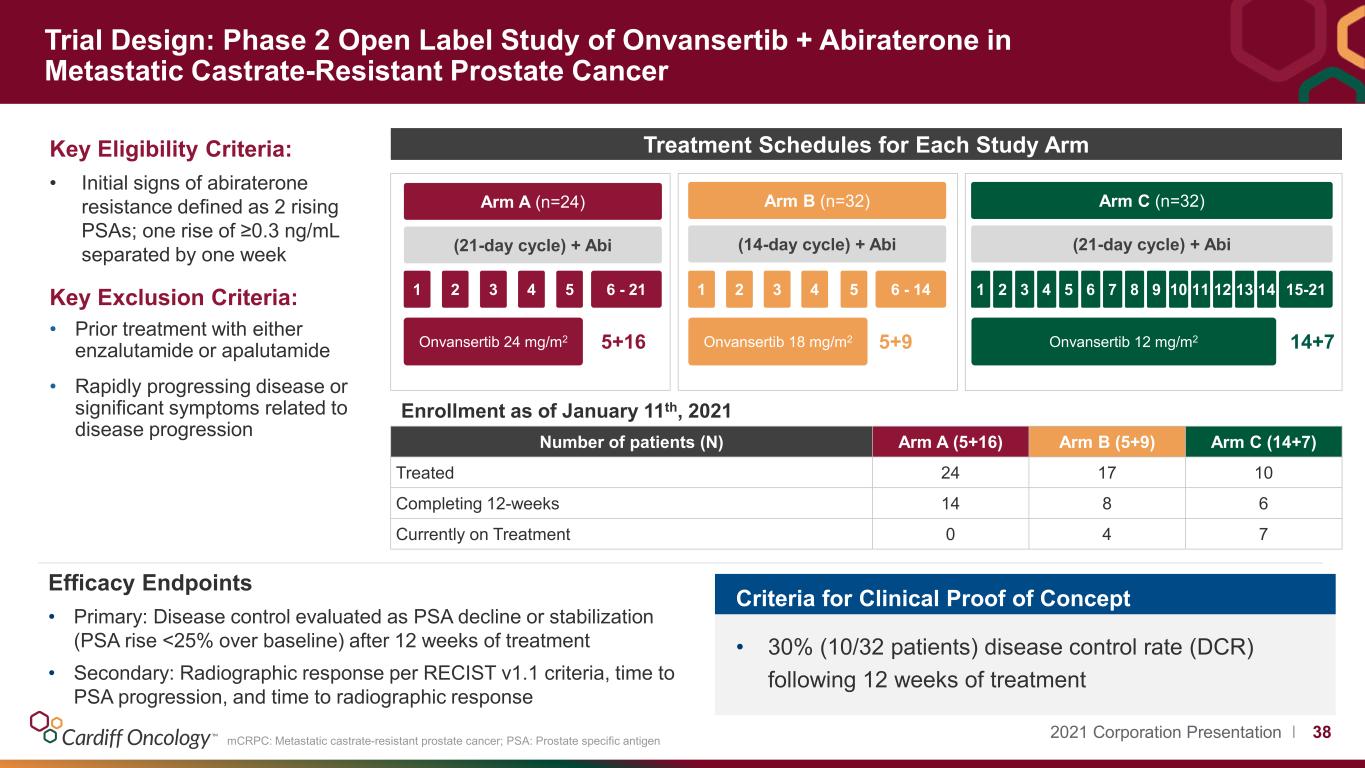
2021 Corporation Presentation I 38mCRPC: Metastatic castrate-resistant prostate cancer; PSA: Prostate specific antigen Key Eligibility Criteria: • Initial signs of abiraterone resistance defined as 2 rising PSAs; one rise of ≥0.3 ng/mL separated by one week Key Exclusion Criteria: • Prior treatment with either enzalutamide or apalutamide • Rapidly progressing disease or significant symptoms related to disease progression Enrollment as of January 11th, 2021 Number of patients (N) Arm A (5+16) Arm B (5+9) Arm C (14+7) Treated 24 17 10 Completing 12-weeks 14 8 6 Currently on Treatment 0 4 7 Treatment Schedules for Each Study Arm Efficacy Endpoints • Primary: Disease control evaluated as PSA decline or stabilization (PSA rise <25% over baseline) after 12 weeks of treatment • Secondary: Radiographic response per RECIST v1.1 criteria, time to PSA progression, and time to radiographic response (21-day cycle) + Abi 6 - 212 3 4 51 Onvansertib 24 mg/m2 Arm A (n=24) 5+16 (14-day cycle) + Abi 6 - 142 3 4 51 Onvansertib 18 mg/m2 Arm B (n=32) 5+9 (21-day cycle) + Abi 2 3 4 51 Onvansertib 12 mg/m2 Arm C (n=32) 6 7 8 9 10 11 12 13 14 15-21 14+7 • 30% (10/32 patients) disease control rate (DCR) following 12 weeks of treatment Criteria for Clinical Proof of Concept Trial Design: Phase 2 Open Label Study of Onvansertib + Abiraterone in Metastatic Castrate-Resistant Prostate Cancer
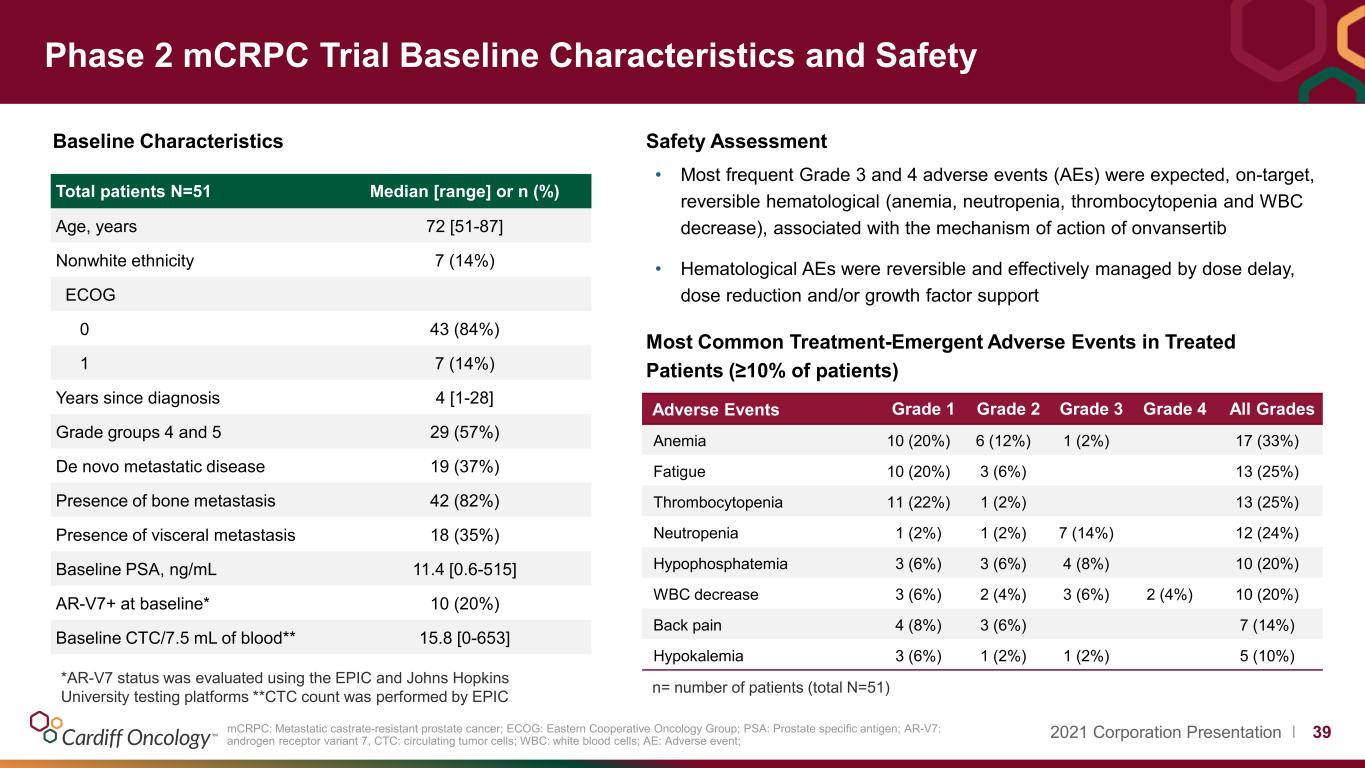
2021 Corporation Presentation I 39 • Most frequent Grade 3 and 4 adverse events (AEs) were expected, on-target, reversible hematological (anemia, neutropenia, thrombocytopenia and WBC decrease), associated with the mechanism of action of onvansertib • Hematological AEs were reversible and effectively managed by dose delay, dose reduction and/or growth factor support mCRPC: Metastatic castrate-resistant prostate cancer; ECOG: Eastern Cooperative Oncology Group; PSA: Prostate specific antigen; AR-V7: androgen receptor variant 7, CTC: circulating tumor cells; WBC: white blood cells; AE: Adverse event; Total patients N=51 Median [range] or n (%) Age, years 72 [51-87] Nonwhite ethnicity 7 (14%) ECOG 0 43 (84%) 1 7 (14%) Years since diagnosis 4 [1-28] Grade groups 4 and 5 29 (57%) De novo metastatic disease 19 (37%) Presence of bone metastasis 42 (82%) Presence of visceral metastasis 18 (35%) Baseline PSA, ng/mL 11.4 [0.6-515] AR-V7+ at baseline* 10 (20%) Baseline CTC/7.5 mL of blood** 15.8 [0-653] *AR-V7 status was evaluated using the EPIC and Johns Hopkins University testing platforms **CTC count was performed by EPIC Baseline Characteristics Safety Assessment Adverse Events Grade 1 Grade 2 Grade 3 Grade 4 All Grades Anemia 10 (20%) 6 (12%) 1 (2%) 17 (33%) Fatigue 10 (20%) 3 (6%) 13 (25%) Thrombocytopenia 11 (22%) 1 (2%) 13 (25%) Neutropenia 1 (2%) 1 (2%) 7 (14%) 12 (24%) Hypophosphatemia 3 (6%) 3 (6%) 4 (8%) 10 (20%) WBC decrease 3 (6%) 2 (4%) 3 (6%) 2 (4%) 10 (20%) Back pain 4 (8%) 3 (6%) 7 (14%) Hypokalemia 3 (6%) 1 (2%) 1 (2%) 5 (10%) Most Common Treatment-Emergent Adverse Events in Treated Patients (≥10% of patients) n= number of patients (total N=51) Phase 2 mCRPC Trial Baseline Characteristics and Safety
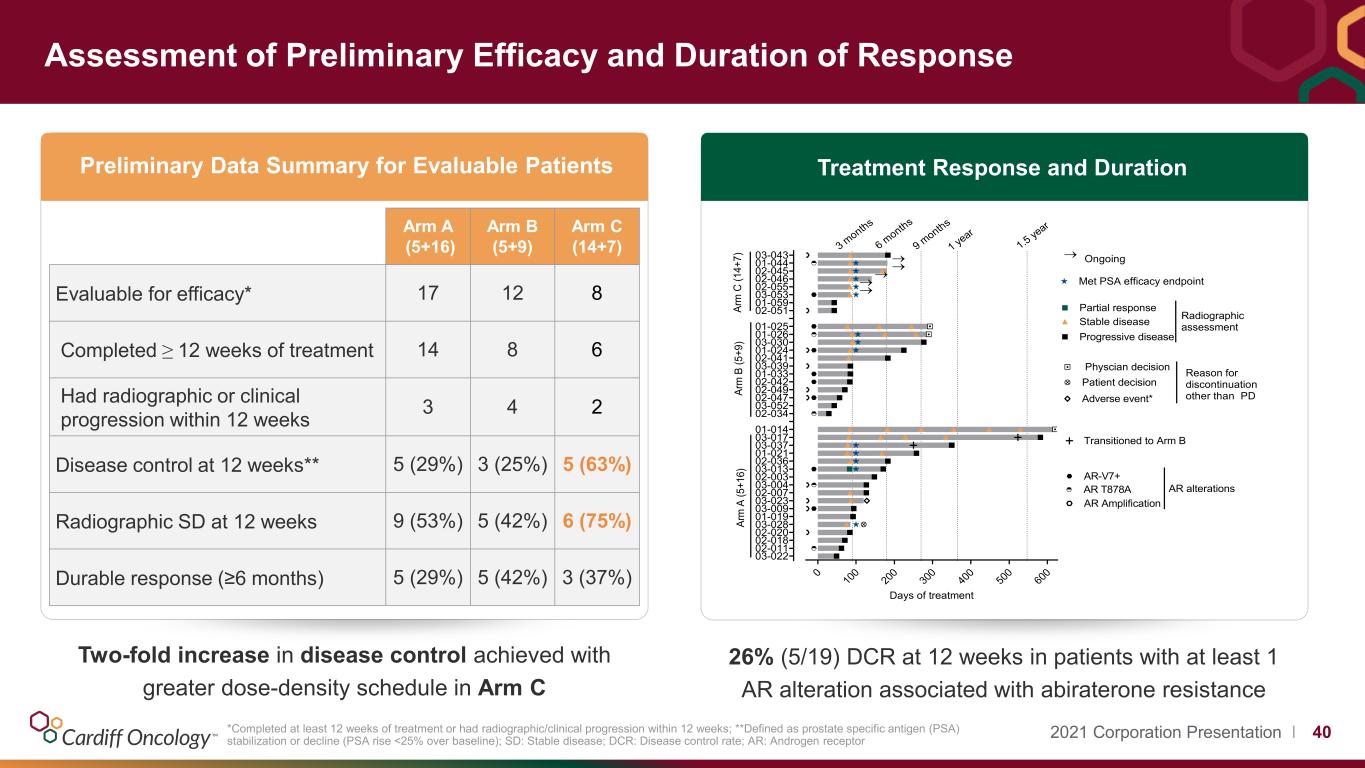
2021 Corporation Presentation I 40*Completed at least 12 weeks of treatment or had radiographic/clinical progression within 12 weeks; **Defined as prostate specific antigen (PSA) stabilization or decline (PSA rise <25% over baseline); SD: Stable disease; DCR: Disease control rate; AR: Androgen receptor Two-fold increase in disease control achieved with greater dose-density schedule in Arm C Treatment Response and DurationPreliminary Data Summary for Evaluable Patients Arm A (5+16) Arm B (5+9) Arm C (14+7) Evaluable for efficacy* 17 12 8 Completed ≥ 12 weeks of treatment 14 8 6 Had radiographic or clinical progression within 12 weeks 3 4 2 Disease control at 12 weeks** 5 (29%) 3 (25%) 5 (63%) Radiographic SD at 12 weeks 9 (53%) 5 (42%) 6 (75%) Durable response (≥6 months) 5 (29%) 5 (42%) 3 (37%) 0 100 200 300 400 500 600 03-022 02-011 02-018 02-020 03-028 01-019 03-009 03-023 02-007 03-004 02-003 03-013 02-036 01-021 03-037 03-017 01-014 02-034 03-052 02-047 02-049 02-042 01-033 03-039 02-041 01-024 03-030 01-026 01-025 02-051 01-059 03-053 02-055 02-046 02-045 01-044 03-043 → → → → → Days of treatment Progressive disease Stable disease Partial response Radiographic assessment AR-V7+ AR T878A AR alterations Transitioned to Arm B 3 m on ths 6 m on ths 9 m on ths 1 y ea r A rm B (5 +9 ) A rm A (5 +1 6) 1.5 ye ar Physcian decision Patient decision Adverse event* Reason for discontinuation other than PD AR Amplification Met PSA efficacy endpoint A rm C (1 4+ 7) Ongoing→ 26% (5/19) DCR at 12 weeks in patients with at least 1 AR alteration associated with abiraterone resistance Assessment of Preliminary Efficacy and Duration of Response
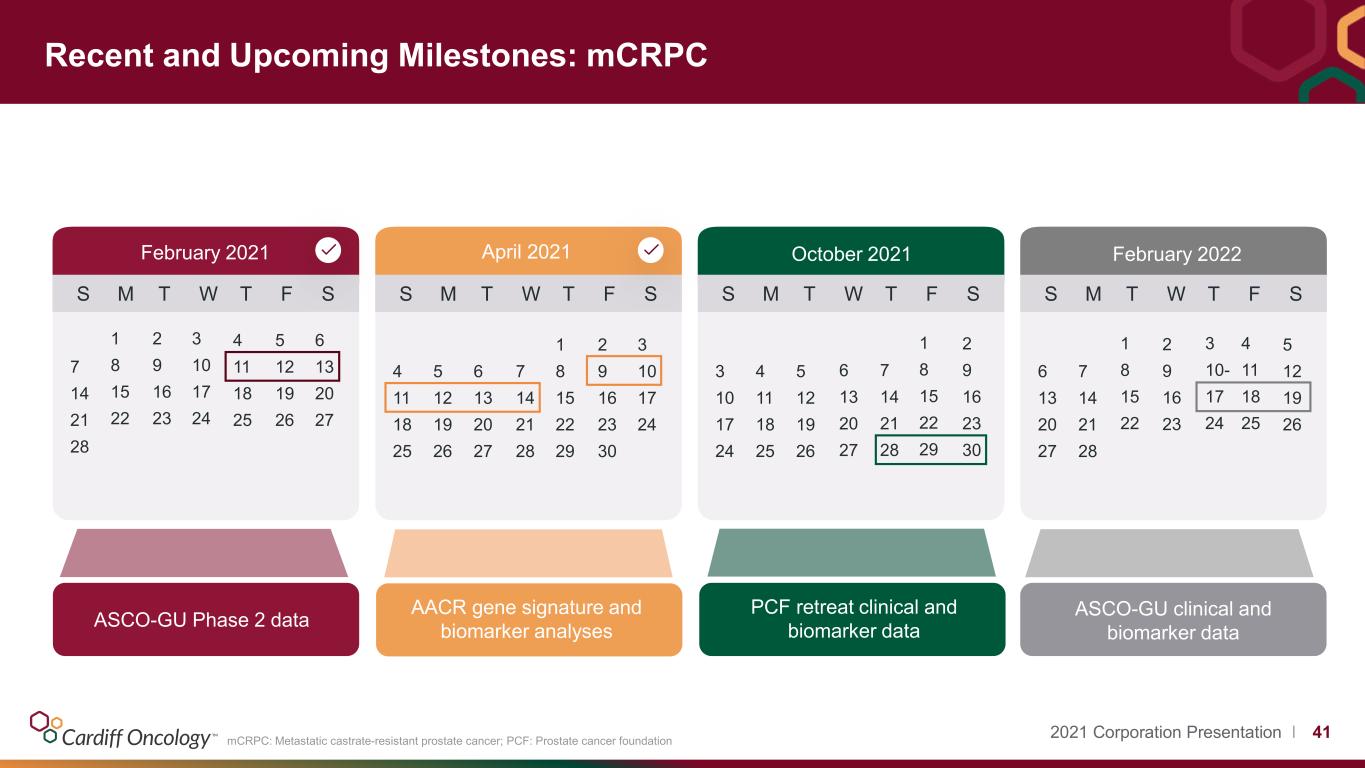
2021 Corporation Presentation I 41 7 14 21 28 1 8 15 22 2 9 16 23 3 10 17 24 4 11 18 25 5 12 19 26 6 13 20 27 S February 2021 M T W T F S 4 11 18 25 5 12 19 26 6 13 20 27 7 14 21 28 1 8 15 22 29 2 9 16 23 30 3 10 17 24 S April 2021 M T W T F S 3 10 17 24 4 11 18 25 5 12 19 26 6 13 20 27 2 9 16 23 30 S October 2021 M T W T F S 6 13 20 27 7 14 21 28 1 8 15 22 2 9 16 23 3 10- 17 24 4 11 18 25 5 12 19 26 S February 2022 M T W T F S PCF retreat clinical and biomarker dataASCO-GU Phase 2 data AACR gene signature and biomarker analyses ASCO-GU clinical and biomarker data 7 14 21 28 1 8 15 22 29 Recent and Upcoming Milestones: mCRPC mCRPC: Metastatic castrate-resistant prostate cancer; PCF: Prostate cancer foundation
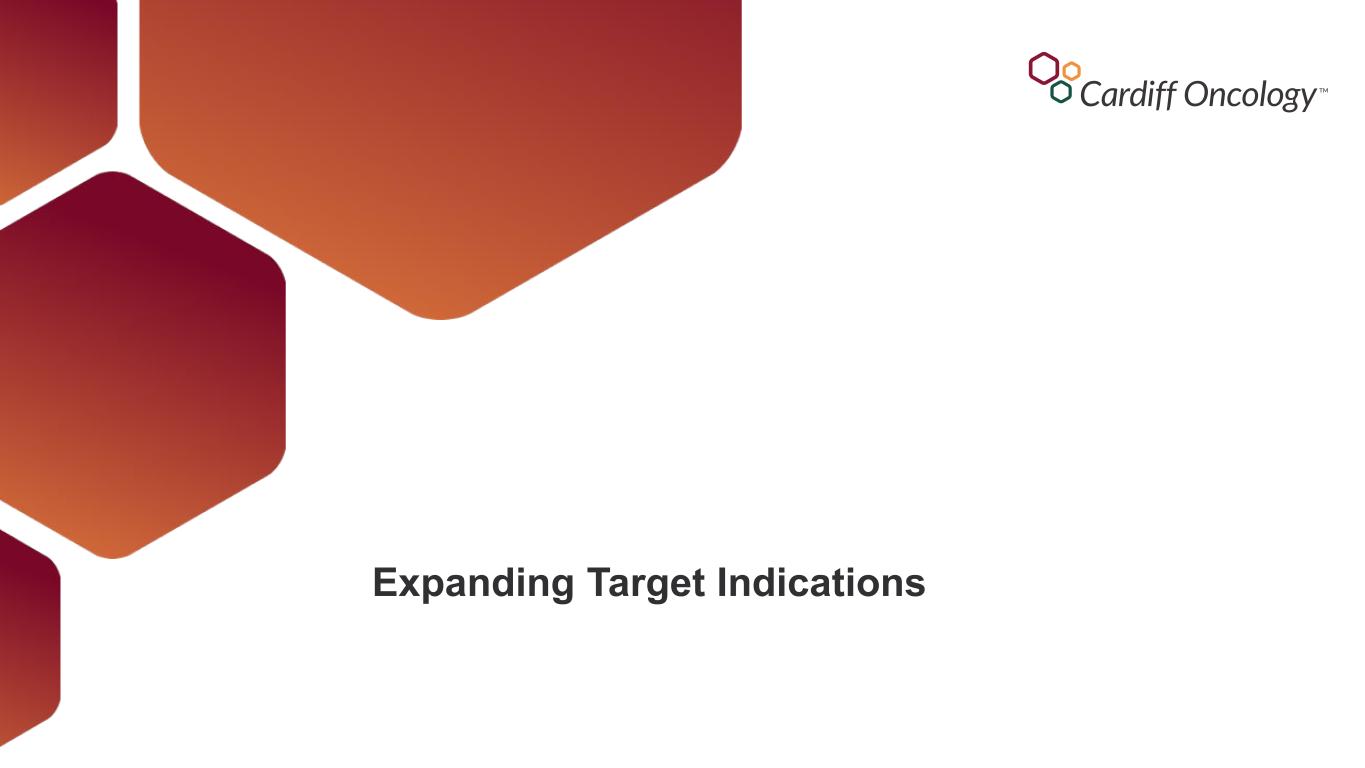
Expanding Target Indications

2021 Corporation Presentation I 43 SCLC: Small cell lung cancer; TNBC: Triple negative breast cancer; PANC: Pancreatic cancer; CRC: Colorectal cancer; WT: Wild-type Preclinical Programs to Expand Onvansertib Pipeline of Indications TNBC PARP Inhibitors, Paclitaxel Ovarian PARP Inhibitors CRC Erbitux (EGFR) KRAS WT G12C Inhibitors KRAS SCLC Irinotecan Onvansertib single agent Prostate PARP Inhibitors PANC Onvansertib single agent Exploratory combinationsOnvansertib Pediatric Medulloblastomas Combination with radiation
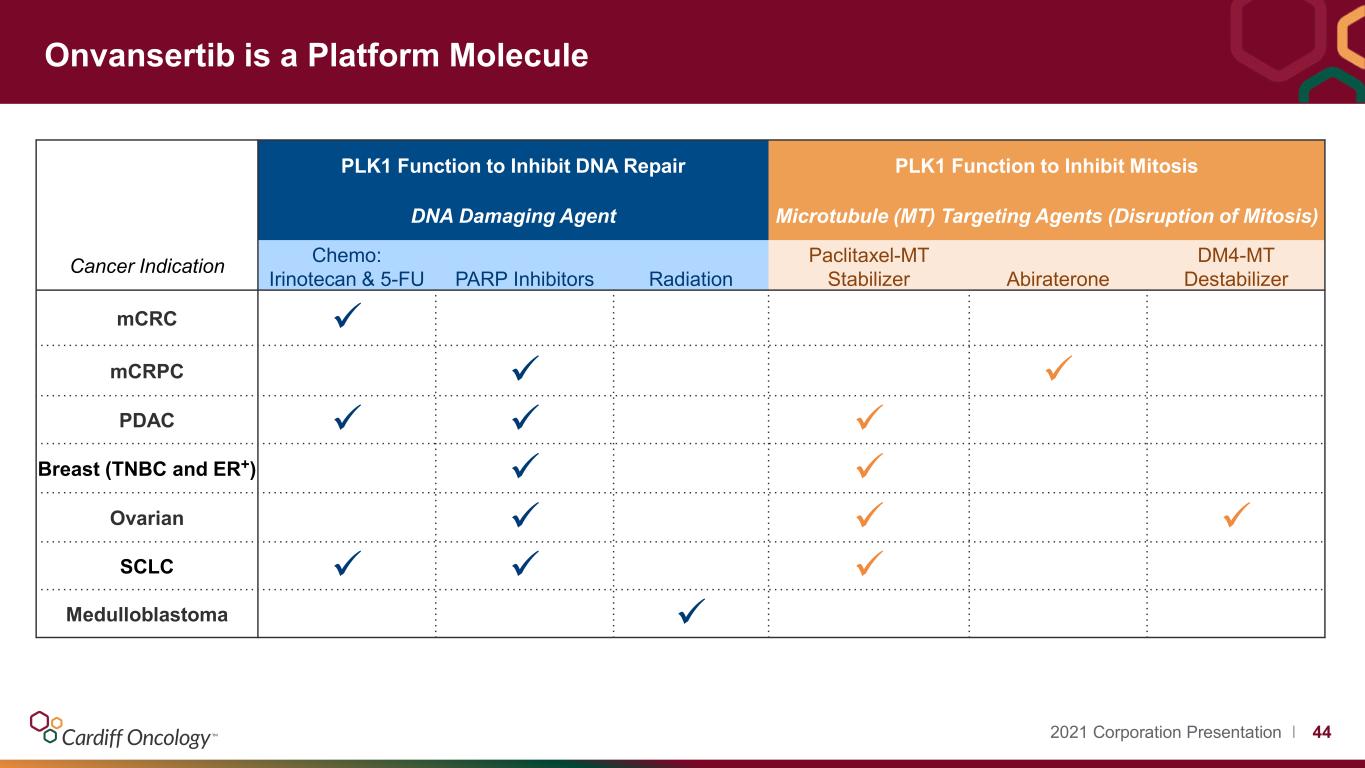
2021 Corporation Presentation I 44 Onvansertib is a Platform Molecule PLK1 Function to Inhibit DNA Repair PLK1 Function to Inhibit Mitosis DNA Damaging Agent Microtubule (MT) Targeting Agents (Disruption of Mitosis) Cancer Indication Chemo: Irinotecan & 5-FU PARP Inhibitors Radiation Paclitaxel-MT Stabilizer Abiraterone DM4-MT Destabilizer mCRC mCRPC PDAC Breast (TNBC and ER+) Ovarian SCLC Medulloblastoma
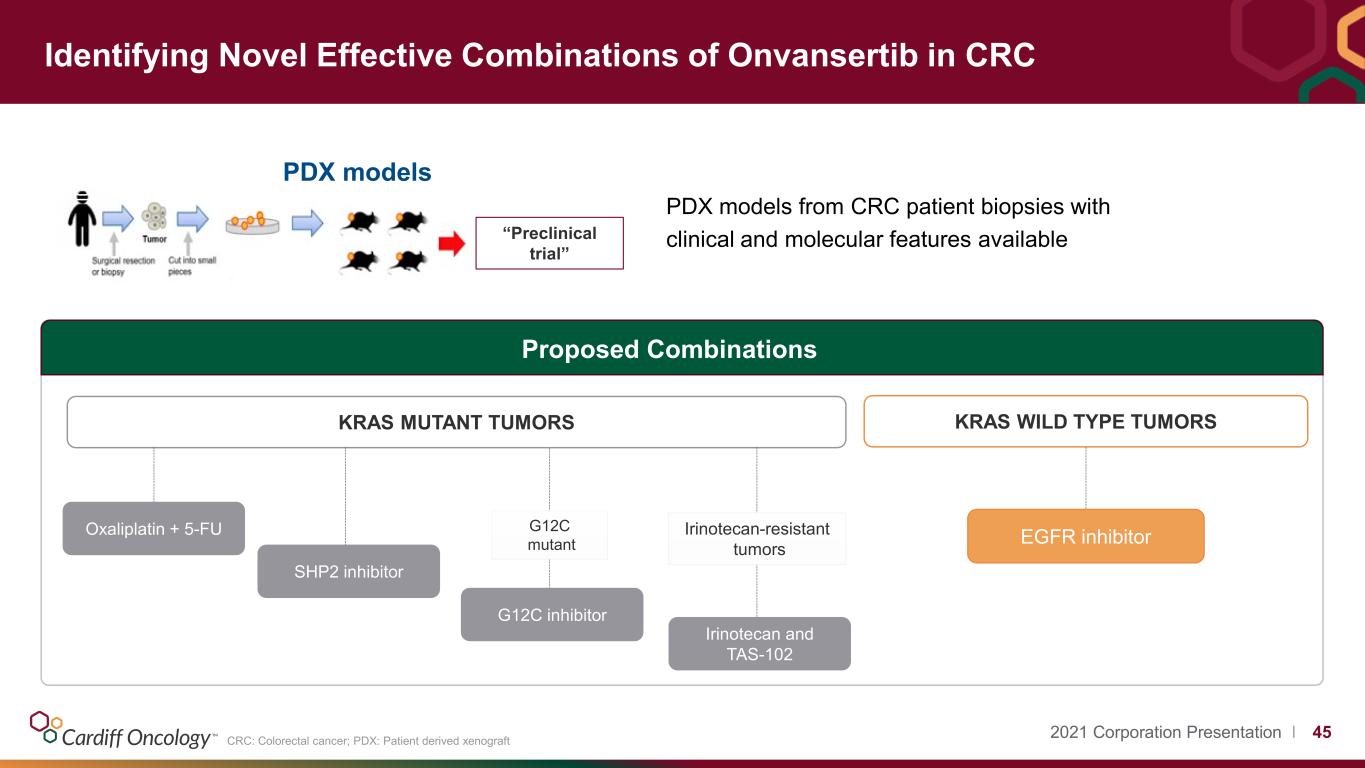
2021 Corporation Presentation I 45CRC: Colorectal cancer; PDX: Patient derived xenograft Identifying Novel Effective Combinations of Onvansertib in CRC PDX models from CRC patient biopsies with clinical and molecular features available“Preclinical trial” PDX models Proposed Combinations KRAS WILD TYPE TUMORS EGFR inhibitor KRAS MUTANT TUMORS Irinotecan-resistant tumors Irinotecan and TAS-102 G12C inhibitor G12C mutant SHP2 inhibitor Oxaliplatin + 5-FU
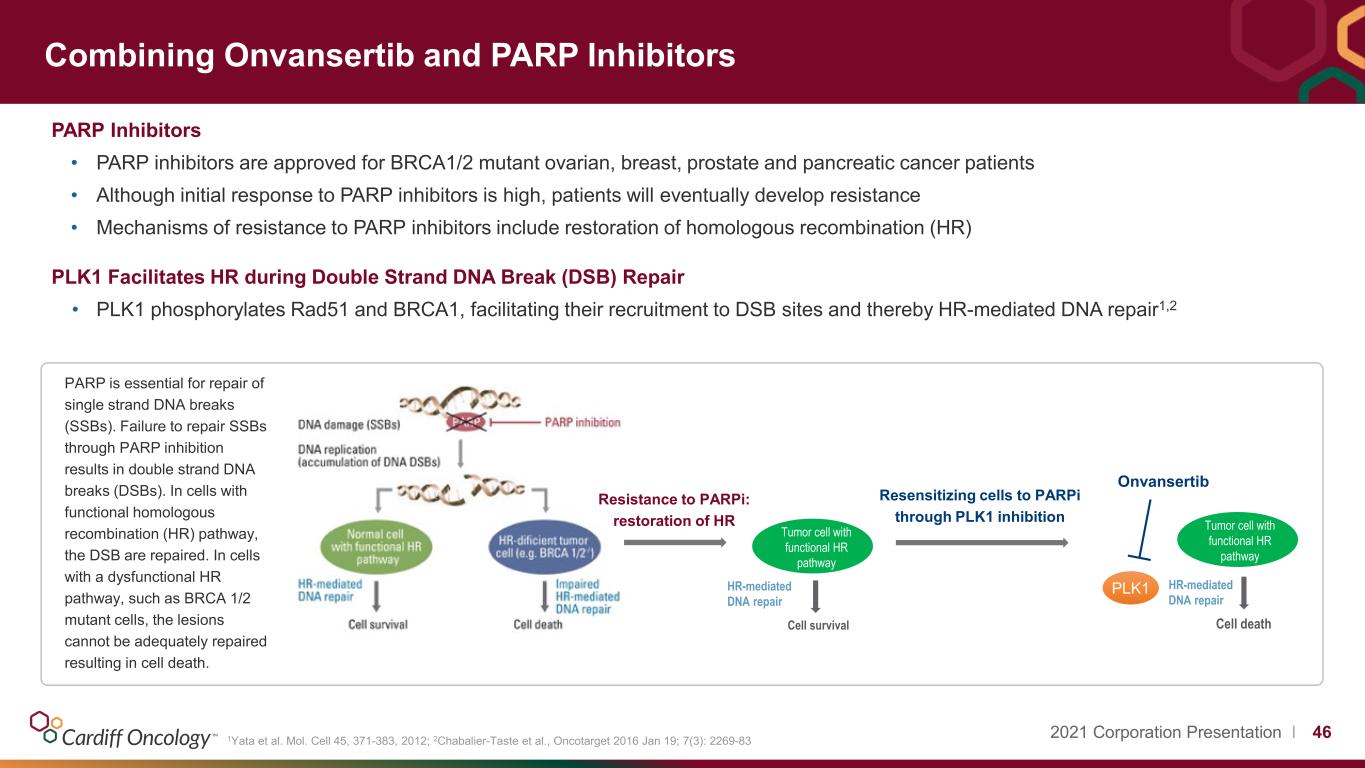
2021 Corporation Presentation I 461Yata et al. Mol. Cell 45, 371-383, 2012; 2Chabalier-Taste et al., Oncotarget 2016 Jan 19; 7(3): 2269-83 PARP Inhibitors • PARP inhibitors are approved for BRCA1/2 mutant ovarian, breast, prostate and pancreatic cancer patients • Although initial response to PARP inhibitors is high, patients will eventually develop resistance • Mechanisms of resistance to PARP inhibitors include restoration of homologous recombination (HR) PLK1 Facilitates HR during Double Strand DNA Break (DSB) Repair • PLK1 phosphorylates Rad51 and BRCA1, facilitating their recruitment to DSB sites and thereby HR-mediated DNA repair1,2 PARP is essential for repair of single strand DNA breaks (SSBs). Failure to repair SSBs through PARP inhibition results in double strand DNA breaks (DSBs). In cells with functional homologous recombination (HR) pathway, the DSB are repaired. In cells with a dysfunctional HR pathway, such as BRCA 1/2 mutant cells, the lesions cannot be adequately repaired resulting in cell death. Resistance to PARPi: restoration of HR Tumor cell with functional HR pathway Cell survival HR-mediated DNA repair Onvansertib Cell death PLK1 Tumor cell with functional HR pathway Resensitizing cells to PARPi through PLK1 inhibition HR-mediated DNA repair Combining Onvansertib and PARP Inhibitors
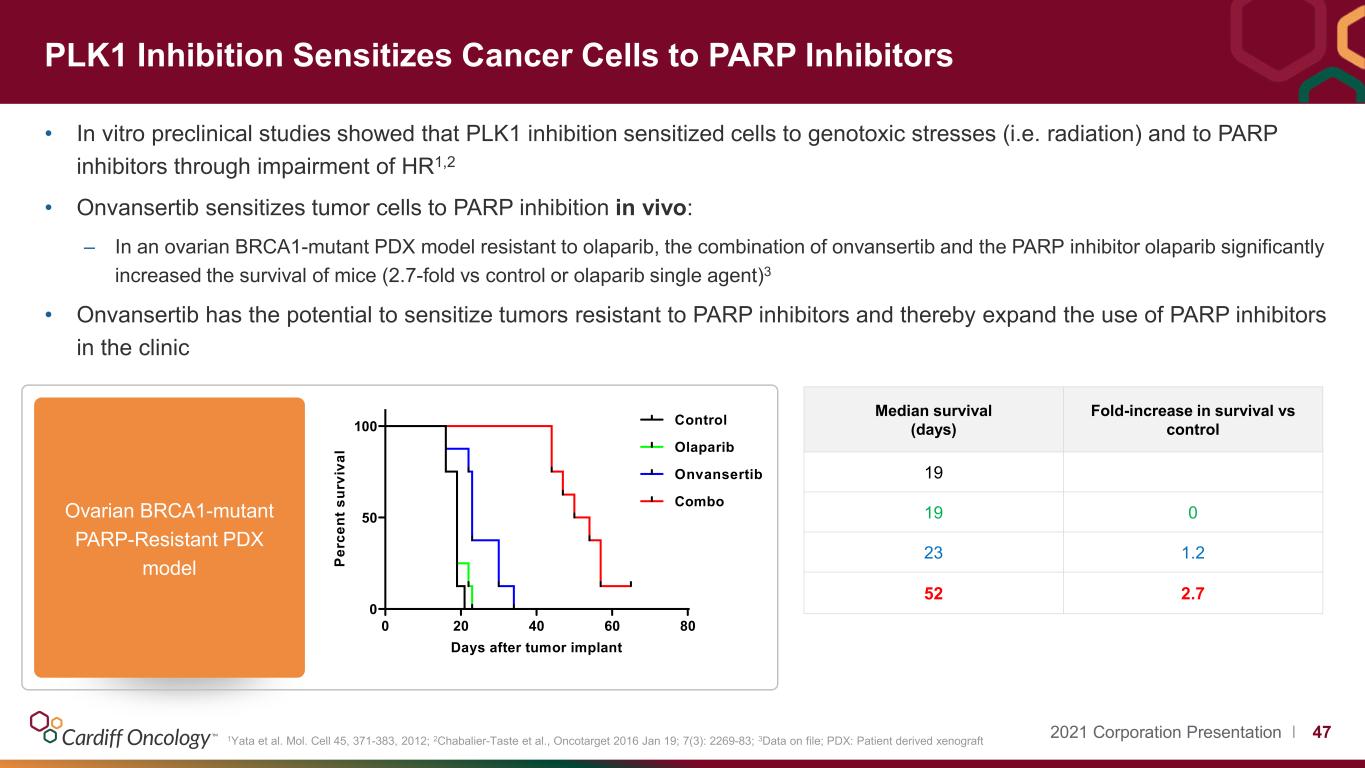
2021 Corporation Presentation I 471Yata et al. Mol. Cell 45, 371-383, 2012; 2Chabalier-Taste et al., Oncotarget 2016 Jan 19; 7(3): 2269-83; 3Data on file; PDX: Patient derived xenograft PLK1 Inhibition Sensitizes Cancer Cells to PARP Inhibitors • In vitro preclinical studies showed that PLK1 inhibition sensitized cells to genotoxic stresses (i.e. radiation) and to PARP inhibitors through impairment of HR1,2 • Onvansertib sensitizes tumor cells to PARP inhibition in vivo: – In an ovarian BRCA1-mutant PDX model resistant to olaparib, the combination of onvansertib and the PARP inhibitor olaparib significantly increased the survival of mice (2.7-fold vs control or olaparib single agent)3 • Onvansertib has the potential to sensitize tumors resistant to PARP inhibitors and thereby expand the use of PARP inhibitors in the clinic Median survival (days) Fold-increase in survival vs control 19 19 0 23 1.2 52 2.7 0 20 40 60 80 0 50 100 Days after tumor implant P er ce n t su rv iv al Control Olaparib Onvansertib ComboOvarian BRCA1-mutant PARP-Resistant PDX model
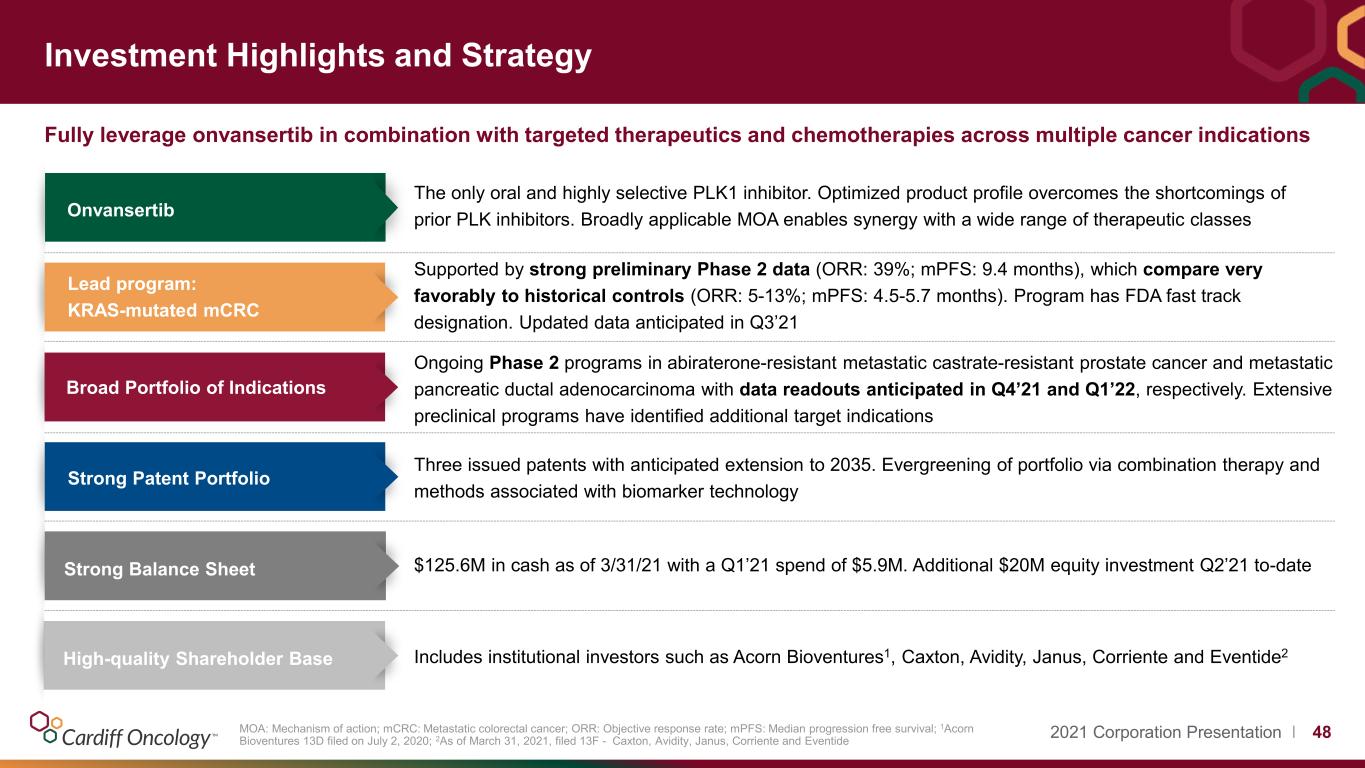
2021 Corporation Presentation I 48 Investment Highlights and Strategy Fully leverage onvansertib in combination with targeted therapeutics and chemotherapies across multiple cancer indications MOA: Mechanism of action; mCRC: Metastatic colorectal cancer; ORR: Objective response rate; mPFS: Median progression free survival; 1Acorn Bioventures 13D filed on July 2, 2020; 2As of March 31, 2021, filed 13F - Caxton, Avidity, Janus, Corriente and Eventide The only oral and highly selective PLK1 inhibitor. Optimized product profile overcomes the shortcomings of prior PLK inhibitors. Broadly applicable MOA enables synergy with a wide range of therapeutic classesOnvansertib Supported by strong preliminary Phase 2 data (ORR: 39%; mPFS: 9.4 months), which compare very favorably to historical controls (ORR: 5-13%; mPFS: 4.5-5.7 months). Program has FDA fast track designation. Updated data anticipated in Q3’21 Lead program: KRAS-mutated mCRC Ongoing Phase 2 programs in abiraterone-resistant metastatic castrate-resistant prostate cancer and metastatic pancreatic ductal adenocarcinoma with data readouts anticipated in Q4’21 and Q1’22, respectively. Extensive preclinical programs have identified additional target indications Broad Portfolio of Indications Three issued patents with anticipated extension to 2035. Evergreening of portfolio via combination therapy and methods associated with biomarker technology Strong Patent Portfolio Includes institutional investors such as Acorn Bioventures1, Caxton, Avidity, Janus, Corriente and Eventide2High-quality Shareholder Base Strong Balance Sheet $125.6M in cash as of 3/31/21 with a Q1’21 spend of $5.9M. Additional $20M equity investment Q2’21 to-date

Thank You for more information contact: ir@cardiffoncology.com
